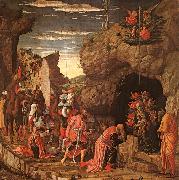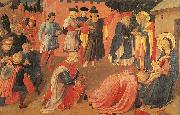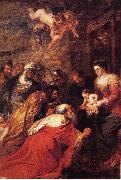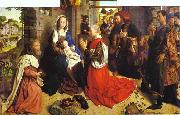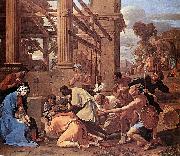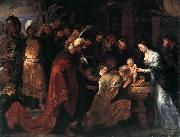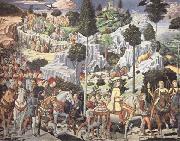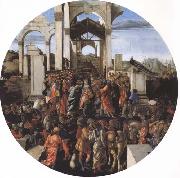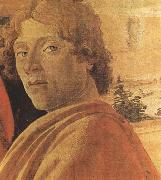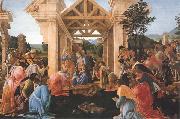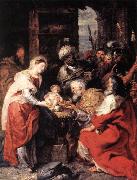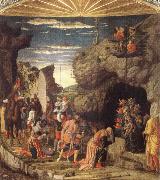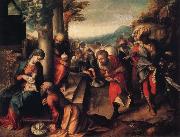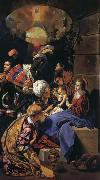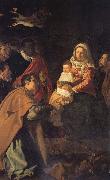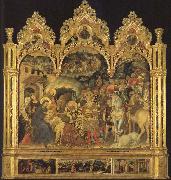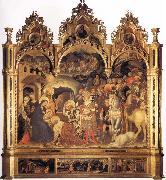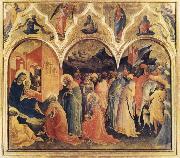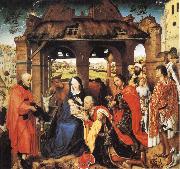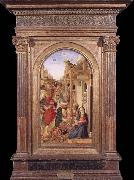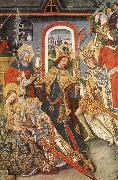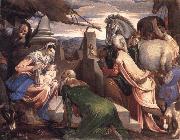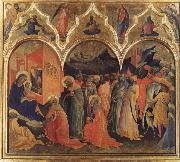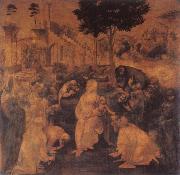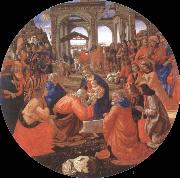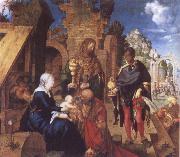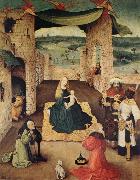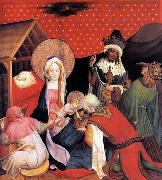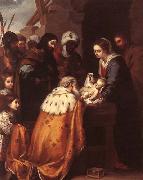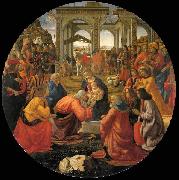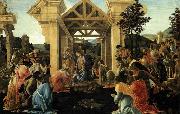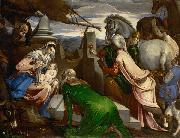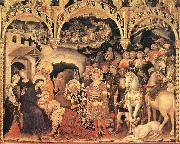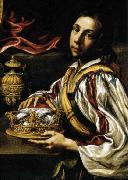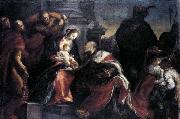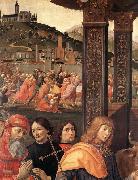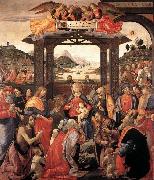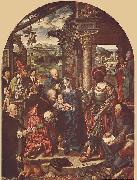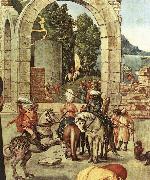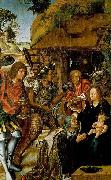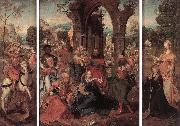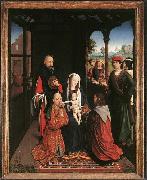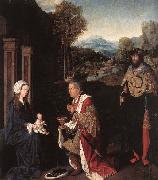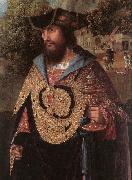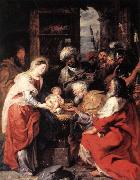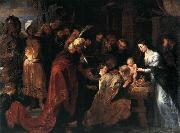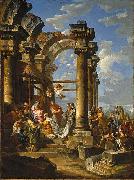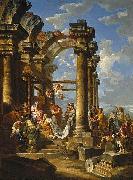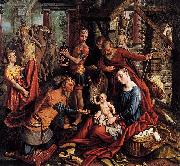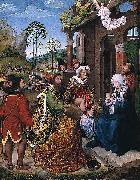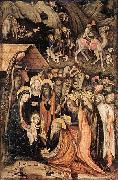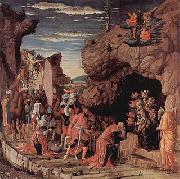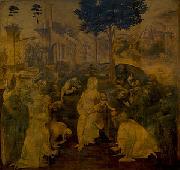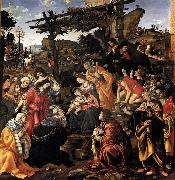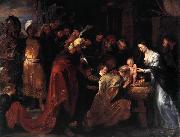Wholesale Oil Painting No Minimum |
|||||||||||
|
|
|||||||||||

|
|||||||||||
|
|
|
||||||||
|
|
||||||||
Adoration of the Magi
Adoration of the Magi Painting ID:: 1104 |
Florence Florence |
|||||||
|
|
||||||||
Andrea MantegnaItalian 1431-1506 Andrea Mantegna Locations Mantegna was born in Isola di Carturo, close to Padua in the Republic of Venice, second son of a carpenter, Biagio. At the age of eleven he became the apprentice of Francesco Squarcione, Paduan painter. Squarcione, whose original vocation was tailoring, appears to have had a remarkable enthusiasm for ancient art, and a faculty for acting. Like his famous compatriot Petrarca, Squarcione was something of a fanatic for ancient Rome: he travelled in Italy, and perhaps Greece, amassing antique statues, reliefs, vases, etc., forming a collection of such works, then making drawings from them himself, and throwing open his stores for others to study. All the while, he continued undertaking works on commission for which his pupils no less than himself were made available. San Zeno Altarpiece, (left panel), 1457-60; San Zeno, VeronaAs many as 137 painters and pictorial students passed through Squarcine's school, which had been established towards 1440 and which became famous all over Italy. Padua was attractive for artists coming not only from Veneto but also from Tuscany, such as Paolo Uccello, Filippo Lippi and Donatello. Mantegna's early career was shaped indeed by impressions of Florentine works. At the time, Mantegna was said to be a favorite pupil; Squarcione taught him the Latin language, and instructed him to study fragments of Roman sculpture. The master also preferred forced perspective, the lingering results of which may account for some Mantegna's later innovations. However, at the age of seventeen, Mantegna separated himself from Squarcione. He later claimed that Squarcione had profited from his work without paying the rights. His first work, now lost, was an altarpiece for the church of Santa Sofia in 1448. The same year Mantegna was called, together with Nicol?? Pizolo, to work with a large group of painters entrusted with the decoration of the Ovetari Chapel in the apse of the church of Eremitani. It is probable, however, that before this time some of the pupils of Squarcione, including Mantegna, had already begun the series of frescoes in the chapel of S. Cristoforo, in the church of Sant'Agostino degli Eremitani, today considered his masterpiece. After a series of coincidences, Mantegna finished most of the work alone, though Ansuino, who collaborated with Mantegna in the Ovetari Chapel, brought his style in the Forl?? school of painting. The now censorious Squarcione carped about the earlier works of this series, illustrating the life of St James; he said the figures were like men of stone, and had better have been colored stone-color at once. This series was almost entirely lost in the 1944 Allied bombings of Padua. The most dramatic work of the fresco cycle was the work set in the worm's-eye view perspective, St. James Led to His Execution. (For an example of Mantegna's use of a lowered view point, see the image at right of Saints Peter and Paul; though much less dramatic in its perspective that the St. James picture, the San Zeno altarpiece was done shortly after the St. James cycle was finished, and uses many of the same techniques, including the classicizing architectural structure.) San Luca Altarpiece, 1453; Tempera on panel; Pinacoteca di Brera, MilanThe sketch of the St. Stephen fresco survived and is the earliest known preliminary sketch which still exists to compare to the corresponding fresco. Despite the authentic look of the monument, it is not a copy of any known Roman structure. Mantegna also adopted the wet drapery patterns of the Romans, who derived the form from the Greek invention, for the clothing of his figures, although the tense figures and interactions are derived from Donatello. The drawing shows proof that nude figures were used in the conception of works during the Early Renaissance. In the preliminary sketch, the perspective is less developed and closer to a more average viewpoint however. Among the other early Mantegna frescoes are the two saints over the entrance porch of the church of Sant'Antonio in Padua, 1452, and an altarpiece of St. Luke and other saints (at left) for the church of S. Giustina, now in the Brera Gallery in Milan (1453). As the young artist progressed in his work, he came under the influence of Jacopo Bellini, father of the celebrated painters Giovanni and Gentile, and of a daughter Nicolosia. In 1453 Jacopo consented to a marriage between Nicolosia to Mantegna in marriage. |
||||||||
|
|
||||||||
|
|
Adoration of the Magi
Adoration of the Magi Painting ID:: 2717 |
Galleria degli Uffizi, Florence Galleria degli Uffizi, Florence |
||||||
|
|
||||||||
Fra AngelicoFra Angelico Galleries b.c. 1400, Vicchio, Florence d.Feb. 18, 1455, Rome Fra Angelico (c. 1395 ?C February 18, 1455), born Guido di Pietro, was an Early Italian Renaissance painter, referred to in Vasari's Lives of the Artists as having "a rare and perfect talent". Known in Italy as il Beato Angelico, he was known to his contemporaries as Fra Giovanni da Fiesole (Brother John from Fiesole). In Giorgio Vasari's Lives of the Artists, written prior to 1555, he was already known as Fra Giovanni Angelico (Brother Giovanni the Angelic One). Within his lifetime or shortly thereafter he was also called Il Beato (the Blessed), in reference to his skills in painting religious subjects. In 1982 Pope John Paul II conferred beatification, thereby making this title official. Fiesole is sometimes misinterpreted as being part of his formal name, but it was merely the name of the town where he took his vows, used by contemporaries to separate him from other Fra Giovannis. He is listed in the Roman Martyrology as Beatus Ioannes Faesulanus, cognomento Angelicus??"Blessed Giovanni of Fiesole, nicknamed Angelico". Fra Angelico was working at a time when the style of painting was in a state of change. This process of change had begun a hundred years previous with the works of Giotto and several of his contemporaries, notably Giusto de' Menabuoi, both of whom had created their major works in Padua, although Giotto was trained in Florence by the great Gothic artist, Cimabue, and painted a fresco cycle of St Francis in the Bardi Chapel in Santa Croce. Giotto had many enthusiastic followers, who imitated his style in fresco, some of them, notably the Lorenzetti, achieving great success. |
||||||||
|
|
||||||||
|
|
Adoration of the Magi
Adoration of the Magi Painting ID:: 3254 |
1433-35
Museo San Marco, Florence 1433-35 Museo San Marco, Florence |
||||||
|
|
||||||||
Peter Paul RubensFlemish Baroque Era Painter, 1577-1640 Peter Paul Rubens (June 28, 1577 ?C May 30, 1640) was a prolific seventeenth-century Flemish Baroque painter, and a proponent of an exuberant Baroque style that emphasized movement, color, and sensuality. He is well-known for his Counter-Reformation altarpieces, portraits, landscapes, and history paintings of mythological and allegorical subjects. In addition to running a large studio in Antwerp which produced paintings popular with nobility and art collectors throughout Europe, Rubens was a classically-educated humanist scholar, art collector, and diplomat who was knighted by both Philip IV, king of Spain, and Charles I, king of England. Rubens was a prolific artist. His commissioned works were mostly religious subjects, "history" paintings, which included mythological subjects, and hunt scenes. He painted portraits, especially of friends, and self-portraits, and in later life painted several landscapes. Rubens designed tapestries and prints, as well as his own house. He also oversaw the ephemeral decorations of the Joyous Entry into Antwerp by the Cardinal-Infante Ferdinand in 1635. His drawings are mostly extremely forceful but not detailed; he also made great use of oil sketches as preparatory studies. He was one of the last major artists to make consistent use of wooden panels as a support medium, even for very large works, but he used canvas as well, especially when the work needed to be sent a long distance. For altarpieces he sometimes painted on slate to reduce reflection problems. His fondness of painting full-figured women gave rise to the terms 'Rubensian' or 'Rubenesque' for plus-sized women. The term 'Rubensiaans' is also commonly used in Dutch to denote such women. |
||||||||
|
|
||||||||
|
|
Adoration of the Magi
Adoration of the Magi Painting ID:: 3642 |
King's College Chapel, Cambridge, UK
King's College Chapel, Cambridge, UK |
||||||
|
|
||||||||
Hugo van der Goes1440-1482 Flemish Hugo van der Goes Galleries Hugo became a member of the painters' guild of Ghent as a master in 1467. In 1468 he was involved in the decoration of the town of Bruges in celebration of the marriage between Charles the Bold and Margaret of York and he provided heraldic decorations for Charles's joyeuse entr??e to Ghent in 1469 and again in 1472. He was elected dean of the Ghent guild in 1473 or 1474. In 1475, or some years later, Hugo entered Rooklooster, a monastery near Brussels belonging to the Windesheim Congregation, and professed there as a frater conversus. He continued to paint, and remained at Rooklooster until his death in 1482 or 1483. In 1480 he was called to the town of Leuven to evaluate the Justice Scenes left unfinished by the painter Dieric Bouts on his death in 1475. Shortly after this, Hugo, returning with other members of his monastery from a trip to Cologne, fell into a state of suicidal gloom, declaring himself to be damned. After returning to Rooklooster, Hugo recovered from his illness, and died there. His time at Rooklooster is recorded in the chronicle of his fellow monk, Gaspar Ofhuys. A report by a German physician, Hieronymus M??nzer, from 1495, according to which a painter from Ghent was driven to melancholy by the attempt to equal the Ghent Altarpiece, may refer to Hugo. His most famous surviving work is the Portinari Triptych (Uffizi, Florence), an altarpiece commissioned for the church of San Egidio in the hospital of Santa Maria Nuova in Florence by Tommaso Portinari, the manager of the Bruges branch of the Medici Bank. The triptych arrived in Florence in 1483, apparently some years after its completion by van der Goes. The largest Netherlandish work that could be seen in Florence, it was greatly praised. Giorgio Vasari in his Vite of 1550 referred to it as by "Ugo d'Anversa" ("Hugo of Antwerp"). This the sole documentation for its authorship by Hugo; other works are attributed to him based on stylistic comparison with the altarpiece. Hugo appears to have left a large number of drawings, and either from these or the paintings themselves followers made large numbers of copies of compositions that have not survived from his own hand. A drawing of Jacob and Rachel preserved at Christ Church, Oxford is thought to be a rare surviving autograph drawing. |
||||||||
|
|
||||||||
|
|
Adoration of the Magi
Adoration of the Magi Painting ID:: 10049 |
(central panel of the
Monforte Altar; from
Monforte de Lemos
cloister, Spain).1470
Oil on wood.
Gemaldegalerie,Berlin (central panel of the Monforte Altar; from Monforte de Lemos cloister, Spain).1470 Oil on wood. Gemaldegalerie,Berlin |
||||||
|
|
||||||||
Nicolas PoussinFrench 1594-1665 Nicolas Poussin Galleries The finest collection of Poussin's paintings, in addition to his drawings, is located in the Louvre in Paris. Besides the pictures in the National Gallery and at Dulwich, England possesses several of his most considerable works: The Triumph of Pan is at Basildon House, near to Pangbourne, (Berkshire), and his great allegorical painting of the Arts at Knowsley. The later version of Tancred and Erminia is at the Barber Institute in Birmingham. At Rome, in the Colonna and Valentini Palaces, are notable works by him, and one of the private apartments of Prince Doria is decorated by a great series of landscapes in distemper. Throughout his life he stood aloof from the popular movement of his native school. French art in his day was purely decorative, but in Poussin we find a survival of the impulses of the Renaissance coupled with conscious reference to classic work as the standard of excellence. In general we see his paintings at a great disadvantage: for the color, even of the best preserved, has changed in parts, so that the harmony is disturbed; and the noble construction of his designs can be better seen in engravings than in the original. Among the many who have reproduced his works, Audran, Claudine Stella, Picart and Pesne are the most successful. |
||||||||
|
|
||||||||
|
|
Adoration of the Magi
Adoration of the Magi Painting ID:: 10098 |
1633Oil on canvas,
160x182cm Dresden 1633Oil on canvas, 160x182cm Dresden |
||||||
|
|
||||||||
RUBENS, Pieter PauwelFlemish Baroque Era Painter, 1577-1640 |
||||||||
|
|
||||||||
|
|
Adoration of the Magi
Adoration of the Magi Painting ID:: 29672 |
1618-19
Oil on canvas, 245 x 325 cm 1618-19 Oil on canvas, 245 x 325 cm |
||||||
|
|
||||||||
Sandro BotticelliItalian Early Renaissance Painter, 1445-1510 Italian painter and draughtsman. In his lifetime he was one of the most esteemed painters in Italy, enjoying the patronage of the leading families of Florence, in particular the Medici and their banking clients. He was summoned to take part in the decoration of the Sistine Chapel in Rome, was highly commended by diplomatic agents to Ludovico Sforza in Milan and Isabella d Este in Mantua and also received enthusiastic praise from the famous mathematician Luca Pacioli and the humanist poet Ugolino Verino. By the time of his death, however, Botticelli s reputation was already waning. He was overshadowed first by the advent of what Vasari called the maniera devota, a new style by Perugino, Francesco Francia and the young Raphael, whose new and humanly affective sentiment, infused atmospheric effects and sweet colourism took Italy by storm; he was then eclipsed with the establishment immediately afterwards of the High Renaissance style, which Vasari called the modern manner, in the paintings of Michelangelo and the mature works of Raphael in the Vatican. From that time his name virtually disappeared until the reassessment of his reputation that gathered momentum in the 1890s |
||||||||
|
|
||||||||
|
|
Adoration of the Magi
Adoration of the Magi Painting ID:: 26714 |
1476
Tempera on wood
111x134cm
Uffizi,Florence
1476 Tempera on wood 111x134cm Uffizi,Florence |
||||||
|
|
||||||||
Sandro BotticelliItalian Early Renaissance Painter, 1445-1510 Italian painter and draughtsman. In his lifetime he was one of the most esteemed painters in Italy, enjoying the patronage of the leading families of Florence, in particular the Medici and their banking clients. He was summoned to take part in the decoration of the Sistine Chapel in Rome, was highly commended by diplomatic agents to Ludovico Sforza in Milan and Isabella d Este in Mantua and also received enthusiastic praise from the famous mathematician Luca Pacioli and the humanist poet Ugolino Verino. By the time of his death, however, Botticelli s reputation was already waning. He was overshadowed first by the advent of what Vasari called the maniera devota, a new style by Perugino, Francesco Francia and the young Raphael, whose new and humanly affective sentiment, infused atmospheric effects and sweet colourism took Italy by storm; he was then eclipsed with the establishment immediately afterwards of the High Renaissance style, which Vasari called the modern manner, in the paintings of Michelangelo and the mature works of Raphael in the Vatican. From that time his name virtually disappeared until the reassessment of his reputation that gathered momentum in the 1890s |
||||||||
|
|
||||||||
|
|
Adoration of the Magi
Adoration of the Magi Painting ID:: 26839 |
1472--1474
London,National Gallery 1472--1474 London,National Gallery |
||||||
|
|
||||||||
Sandro BotticelliItalian Early Renaissance Painter, 1445-1510 Italian painter and draughtsman. In his lifetime he was one of the most esteemed painters in Italy, enjoying the patronage of the leading families of Florence, in particular the Medici and their banking clients. He was summoned to take part in the decoration of the Sistine Chapel in Rome, was highly commended by diplomatic agents to Ludovico Sforza in Milan and Isabella d Este in Mantua and also received enthusiastic praise from the famous mathematician Luca Pacioli and the humanist poet Ugolino Verino. By the time of his death, however, Botticelli s reputation was already waning. He was overshadowed first by the advent of what Vasari called the maniera devota, a new style by Perugino, Francesco Francia and the young Raphael, whose new and humanly affective sentiment, infused atmospheric effects and sweet colourism took Italy by storm; he was then eclipsed with the establishment immediately afterwards of the High Renaissance style, which Vasari called the modern manner, in the paintings of Michelangelo and the mature works of Raphael in the Vatican. From that time his name virtually disappeared until the reassessment of his reputation that gathered momentum in the 1890s |
||||||||
|
|
||||||||
|
|
Adoration of the Magi
Adoration of the Magi Painting ID:: 26849 |
1475-1476
detail of youth in a red tunic,standing on the left (Giuliano de' Medici?)Florence,Galleria degli Uffizi (mk57) 1475-1476 detail of youth in a red tunic,standing on the left (Giuliano de' Medici?)Florence,Galleria degli Uffizi (mk57) |
||||||
|
|
||||||||
Sandro BotticelliItalian Early Renaissance Painter, 1445-1510 Italian painter and draughtsman. In his lifetime he was one of the most esteemed painters in Italy, enjoying the patronage of the leading families of Florence, in particular the Medici and their banking clients. He was summoned to take part in the decoration of the Sistine Chapel in Rome, was highly commended by diplomatic agents to Ludovico Sforza in Milan and Isabella d Este in Mantua and also received enthusiastic praise from the famous mathematician Luca Pacioli and the humanist poet Ugolino Verino. By the time of his death, however, Botticelli s reputation was already waning. He was overshadowed first by the advent of what Vasari called the maniera devota, a new style by Perugino, Francesco Francia and the young Raphael, whose new and humanly affective sentiment, infused atmospheric effects and sweet colourism took Italy by storm; he was then eclipsed with the establishment immediately afterwards of the High Renaissance style, which Vasari called the modern manner, in the paintings of Michelangelo and the mature works of Raphael in the Vatican. From that time his name virtually disappeared until the reassessment of his reputation that gathered momentum in the 1890s |
||||||||
|
|
||||||||
|
|
Adoration of the Magi
Adoration of the Magi Painting ID:: 26878 |
1475--1476
Florence,Galleria degli Uffizi. (mk57) 1475--1476 Florence,Galleria degli Uffizi. (mk57) |
||||||
|
|
||||||||
Sandro BotticelliItalian Early Renaissance Painter, 1445-1510 Italian painter and draughtsman. In his lifetime he was one of the most esteemed painters in Italy, enjoying the patronage of the leading families of Florence, in particular the Medici and their banking clients. He was summoned to take part in the decoration of the Sistine Chapel in Rome, was highly commended by diplomatic agents to Ludovico Sforza in Milan and Isabella d Este in Mantua and also received enthusiastic praise from the famous mathematician Luca Pacioli and the humanist poet Ugolino Verino. By the time of his death, however, Botticelli s reputation was already waning. He was overshadowed first by the advent of what Vasari called the maniera devota, a new style by Perugino, Francesco Francia and the young Raphael, whose new and humanly affective sentiment, infused atmospheric effects and sweet colourism took Italy by storm; he was then eclipsed with the establishment immediately afterwards of the High Renaissance style, which Vasari called the modern manner, in the paintings of Michelangelo and the mature works of Raphael in the Vatican. From that time his name virtually disappeared until the reassessment of his reputation that gathered momentum in the 1890s |
||||||||
|
|
||||||||
|
|
Adoration of the Magi
Adoration of the Magi Painting ID:: 26918 |
c 1482
Washington,National Gallery of Art (mk57) c 1482 Washington,National Gallery of Art (mk57) |
||||||
|
|
||||||||
BRUEGHEL, Pieter the YoungerFlemish painter (b. 1564, Bruxelles, d. 1638, Antwerp). Pieter Brueghel the Younger was the oldest son of the famous sixteenth-century Netherlandish painter Pieter Brueghel the Elder (known as "Peasant Brueghel") and Mayken Coecke van Aelst. His father died in 1569, when Pieter the younger was only five years old. Then, following the death of his mother in 1578, Pieter, along with his brother Jan Brueghel the Elder ("Velvet Brueghel") and sister Marie, went to live with their grandmother Mayken Verhulst (widow of Pieter Coecke van Aelst). She was an artist in her own right, and according to Carel van Mander, possibly the first teacher of the two sons. The family moved to Antwerp sometime after 1578 and Pieter possibly entered the studio of the landscape painter Gillis van Coninxloo (1544-1607). In the 1584/1585 registers of Guild of Saint Luke, "Peeter Brugel" is listed as an independent master. On November 5, 1588 he married Elisabeth Goddelet, and the couple had seven children. He painted landscapes, religious subjects and fantasy paintings. For this last category he often made use of fire and grotesque figures, leading to his nickname "Hell Brueghel". Apart from these paintings of his own invention, Pieter Brueghel the Younger also copied the works his father had created by using a technique called pouncing. His genre paintings of peasants lack Pieter the Elder's subtlety and humanism, and emphasize the picturesque. |
||||||||
|
|
||||||||
|
|
Adoration of the Magi
Adoration of the Magi Painting ID:: 29156 |
mk65
1638
Oil on canvas
transferred freo panel
14x22"
mk65 1638 Oil on canvas transferred freo panel 14x22" |
||||||
|
|
||||||||
RUBENS, Pieter PauwelFlemish Baroque Era Painter, 1577-1640 |
||||||||
|
|
||||||||
|
|
Adoration of the Magi
Adoration of the Magi Painting ID:: 29663 |
1626-29
Oil on canvas, 283 x 219 cm 1626-29 Oil on canvas, 283 x 219 cm |
||||||
|
|
||||||||
Andrea MantegnaItalian 1431-1506 Andrea Mantegna Locations Mantegna was born in Isola di Carturo, close to Padua in the Republic of Venice, second son of a carpenter, Biagio. At the age of eleven he became the apprentice of Francesco Squarcione, Paduan painter. Squarcione, whose original vocation was tailoring, appears to have had a remarkable enthusiasm for ancient art, and a faculty for acting. Like his famous compatriot Petrarca, Squarcione was something of a fanatic for ancient Rome: he travelled in Italy, and perhaps Greece, amassing antique statues, reliefs, vases, etc., forming a collection of such works, then making drawings from them himself, and throwing open his stores for others to study. All the while, he continued undertaking works on commission for which his pupils no less than himself were made available. San Zeno Altarpiece, (left panel), 1457-60; San Zeno, VeronaAs many as 137 painters and pictorial students passed through Squarcine's school, which had been established towards 1440 and which became famous all over Italy. Padua was attractive for artists coming not only from Veneto but also from Tuscany, such as Paolo Uccello, Filippo Lippi and Donatello. Mantegna's early career was shaped indeed by impressions of Florentine works. At the time, Mantegna was said to be a favorite pupil; Squarcione taught him the Latin language, and instructed him to study fragments of Roman sculpture. The master also preferred forced perspective, the lingering results of which may account for some Mantegna's later innovations. However, at the age of seventeen, Mantegna separated himself from Squarcione. He later claimed that Squarcione had profited from his work without paying the rights. His first work, now lost, was an altarpiece for the church of Santa Sofia in 1448. The same year Mantegna was called, together with Nicol?? Pizolo, to work with a large group of painters entrusted with the decoration of the Ovetari Chapel in the apse of the church of Eremitani. It is probable, however, that before this time some of the pupils of Squarcione, including Mantegna, had already begun the series of frescoes in the chapel of S. Cristoforo, in the church of Sant'Agostino degli Eremitani, today considered his masterpiece. After a series of coincidences, Mantegna finished most of the work alone, though Ansuino, who collaborated with Mantegna in the Ovetari Chapel, brought his style in the Forl?? school of painting. The now censorious Squarcione carped about the earlier works of this series, illustrating the life of St James; he said the figures were like men of stone, and had better have been colored stone-color at once. This series was almost entirely lost in the 1944 Allied bombings of Padua. The most dramatic work of the fresco cycle was the work set in the worm's-eye view perspective, St. James Led to His Execution. (For an example of Mantegna's use of a lowered view point, see the image at right of Saints Peter and Paul; though much less dramatic in its perspective that the St. James picture, the San Zeno altarpiece was done shortly after the St. James cycle was finished, and uses many of the same techniques, including the classicizing architectural structure.) San Luca Altarpiece, 1453; Tempera on panel; Pinacoteca di Brera, MilanThe sketch of the St. Stephen fresco survived and is the earliest known preliminary sketch which still exists to compare to the corresponding fresco. Despite the authentic look of the monument, it is not a copy of any known Roman structure. Mantegna also adopted the wet drapery patterns of the Romans, who derived the form from the Greek invention, for the clothing of his figures, although the tense figures and interactions are derived from Donatello. The drawing shows proof that nude figures were used in the conception of works during the Early Renaissance. In the preliminary sketch, the perspective is less developed and closer to a more average viewpoint however. Among the other early Mantegna frescoes are the two saints over the entrance porch of the church of Sant'Antonio in Padua, 1452, and an altarpiece of St. Luke and other saints (at left) for the church of S. Giustina, now in the Brera Gallery in Milan (1453). As the young artist progressed in his work, he came under the influence of Jacopo Bellini, father of the celebrated painters Giovanni and Gentile, and of a daughter Nicolosia. In 1453 Jacopo consented to a marriage between Nicolosia to Mantegna in marriage. |
||||||||
|
|
||||||||
|
|
Adoration of the Magi
Adoration of the Magi Painting ID:: 30423 |
mk68
Tempera on wood
Florence,Uffizi.
mk68 Tempera on wood Florence,Uffizi. |
||||||
|
|
||||||||
CorreggioItalian 1489-1534 Correggio Locations Italian painter and draughtsman. Apart from his Venetian contemporaries, he was the most important northern Italian painter of the first half of the 16th century. His best-known works are the illusionistic frescoes in the domes of S Giovanni Evangelista and the cathedral in Parma, where he worked from 1520 to 1530. The combination of technical virtuosity and dramatic excitement in these works ensured their importance for later generations of artists. His altarpieces of the same period are equally original and ally intimacy of feeling with an ecstatic quality that seems to anticipate the Baroque. In his paintings of mythological subjects, especially those executed after his return to Correggio around 1530, he created images whose sensuality and abandon have been seen as foreshadowing the Rococo. Vasari wrote that Correggio was timid and virtuous, that family responsibilities made him miserly and that he died from a fever after walking in the sun. He left no letters and, apart from Vasari account, nothing is known of his character or personality beyond what can be deduced from his works. The story that he owned a manuscript of Bonaventura Berlinghieri Geographia, as well as his use of a latinized form of Allegri (Laetus), and his naming of his son after the humanist Pomponius Laetus, all suggest that he was an educated man by the standards of painters in this period. The intelligence of his paintings supports this claim. Relatively unknown in his lifetime, Correggio was to have an enormous posthumous reputation. He was revered by Federico Barocci and the Carracci, and throughout the 17th and 18th centuries his reputation rivalled that of Raphael. |
||||||||
|
|
||||||||
|
|
Adoration of the Magi
Adoration of the Magi Painting ID:: 31608 |
mk74
84x108cm
Milan,
Pinacoteca di Brera
mk74 84x108cm Milan, Pinacoteca di Brera |
||||||
|
|
||||||||
|
|
||||||||
|
|
Adoration of the Magi
Adoration of the Magi Painting ID:: 32199 |
1450-1500
Tempera on wood 1450-1500 Tempera on wood |
||||||
|
|
||||||||
Maino, Juan Bautista delSpanish Baroque Era Painter, 1578-1649 |
||||||||
|
|
||||||||
|
|
Adoration of the Magi
Adoration of the Magi Painting ID:: 32881 |
mk84
1612-13
Madrid,Prado
315x174cm
mk84 1612-13 Madrid,Prado 315x174cm |
||||||
|
|
||||||||
Diego VelazquezSpanish Baroque Era Painter, 1599-1660 Spanish painter. He was one of the most important European artists of the 17th century, spending his career from 1623 in the service of Philip IV of Spain. His early canvases comprised bodegones and religious paintings, but as a court artist he was largely occupied in executing portraits, while also producing some historical, mythological and further religious works. His painting was deeply affected by the work of Rubens and by Venetian artists, especially Titian, as well as by the experience of two trips (1629-31 and 1649-51) to Italy. Under these joint influences he developed a uniquely personal style characterized by very loose, expressive brushwork. Although he had no immediate followers, he was greatly admired by such later painters as Goya and Manet |
||||||||
|
|
||||||||
|
|
Adoration of the Magi
Adoration of the Magi Painting ID:: 32888 |
mk84
1619
Madrid,Prado,canvas
203x125cm
mk84 1619 Madrid,Prado,canvas 203x125cm |
||||||
|
|
||||||||
Francisco de Zurbaran1598-1664 Spanish Francisco de Zurbaran Galleries Spanish baroque painter, active mainly at Llerena, Madrid, and Seville. He worked mostly for ecclesiastical patrons. His early paintings, including Crucifixion (1627; Art Inst., Chicago), St. Michael (Metropolitan Mus.), and St. Francis (City Art Museum, St. Louis), often suggest the austere simplicity of wooden sculpture. The figures, placed close to the picture surface, are strongly modeled in dramatic light against dark backgrounds, indicating the influence of Caravaggio. They were clearly painted as altarpieces or devotional objects. In the 1630s the realistic style seen in his famous Apotheosis of St. Thomas Aquinas (1631; Seville) yields to a more mystical expression in works such as the Adoration of the Shepherds (1638; Grenoble); in this decade he was influenced by Ribera figural types and rapid brushwork. While in Seville, Zurbur??n was clearly influenced by Velazquez. After c.1640 the simple power of Zurbaran work lessened as Murillo influence on his painting increased (e.g., Virgin and Child with St. John, Fine Arts Gall., San Diego, Calif.). There are works by Zurbar??n in the Hispanic Society of America, New York City; the National Gallery, Washington, D.C.; and the Philadelphia Museum of Art.. |
||||||||
|
|
||||||||
|
|
Adoration of the Magi
Adoration of the Magi Painting ID:: 32902 |
mk84
1639-40
Grenoble,canvas
264x176cm
mk84 1639-40 Grenoble,canvas 264x176cm |
||||||
|
|
||||||||
Gentile da FabrianoFabriano ca 1370-Rome 1427 Italian painter, one of the outstanding exponents of the elegant international Gothic style. In 1409 he worked in the Doge's Palace, Venice, painting historical frescoes that subsequently perished. In 1422 he was in Florence where he created his most celebrated painting, the resplendent Strozzi altarpiece (Uffizi). Gentile painted in the spirit and the manner of the older school, with glowing color and lavish use of gilt, thereby achieving a jewellike, courtly style. By 1425 he had responded to the new Florentine realism. His refined forms yielded to a sturdier rendering of figures in the Quaratesi altarpiece (panels are now in the Uffizi; Vatican; National Gall., London; and National Gall. of Art, Washington, D.C.). From 1425 until his death he worked in Siena, Orvieto, and Rome. Gentile died in Rome before the completion of the frescoes of St. John the Baptist in the Lateran Basilica. |
||||||||
|
|
||||||||
|
|
Adoration of the Magi
Adoration of the Magi Painting ID:: 33244 |
mk83
1423
Tempera on wood
173x220cm
mk83 1423 Tempera on wood 173x220cm |
||||||
|
|
||||||||
Duccio di Buoninsegna1255-1318 Italian Duccio di Buoninsegna Locations Italian painter. He was one of the most important painters of the 14th century and like his slightly younger contemporary, Giotto, was a major influence on the course of Italian painting. An innovator, he introduced into Sienese painting new altarpiece designs, a dramatic use of landscape, expressive emotional relationships, extremely complex spatial structures and a subtle interplay of colour. His most important and revolutionary work, the Maeste for Siena Cathedral, was never matched during the 14th century, if at all, and his influence lasted well into the 15th century. |
||||||||
|
|
||||||||
|
|
Adoration of the Magi
Adoration of the Magi Painting ID:: 33314 |
mk86
1308-1311
Tempera on wood
42.5x44cm
mk86 1308-1311 Tempera on wood 42.5x44cm |
||||||
|
|
||||||||
Gentile da FabrianoFabriano ca 1370-Rome 1427 Italian painter, one of the outstanding exponents of the elegant international Gothic style. In 1409 he worked in the Doge's Palace, Venice, painting historical frescoes that subsequently perished. In 1422 he was in Florence where he created his most celebrated painting, the resplendent Strozzi altarpiece (Uffizi). Gentile painted in the spirit and the manner of the older school, with glowing color and lavish use of gilt, thereby achieving a jewellike, courtly style. By 1425 he had responded to the new Florentine realism. His refined forms yielded to a sturdier rendering of figures in the Quaratesi altarpiece (panels are now in the Uffizi; Vatican; National Gall., London; and National Gall. of Art, Washington, D.C.). From 1425 until his death he worked in Siena, Orvieto, and Rome. Gentile died in Rome before the completion of the frescoes of St. John the Baptist in the Lateran Basilica. |
||||||||
|
|
||||||||
|
|
Adoration of the Magi
Adoration of the Magi Painting ID:: 33342 |
mk86
1423
Tempera on wood
303x282cm
Florence,Galleria Degli Uffizi.
mk86 1423 Tempera on wood 303x282cm Florence,Galleria Degli Uffizi. |
||||||
|
|
||||||||
Lorenzo MonacoItalian c1370-c1424 Lorenzo Monaco Gallery was a Florentine painter. He joined the Camaldolese monastery of Santa Maria degli Angeli in Florence in 1391, but he left monastic life before making a lifetime commitment. Despite this fact, he has traditionally been called "Lawrence the Monk." His work shows the influence of the International Gothic style of the late fourteenth century, as well as that of the Sienese school. |
||||||||
|
|
||||||||
|
|
Adoration of the Magi
Adoration of the Magi Painting ID:: 33346 |
mk86
1421/22
Tempera on wood
144x177cm
Florence,Galleria degli Uffizi
mk86 1421/22 Tempera on wood 144x177cm Florence,Galleria degli Uffizi |
||||||
|
|
||||||||
MASACCIOItalian Early Renaissance Painter, 1401-1428 was the first great painter of the Quattrocento period of the Italian Renaissance. His frescoes are the earliest monuments of Humanism, and introduce a plasticity previously unseen in figure painting. The name Masaccio is a humorous version of Tommaso, meaning "big", "fat", "clumsy" or "messy" Tom. The name was created to distinguish him from his principal collaborator, also called Tommaso, who came to be known as Masolino ("little/delicate Tom"). Despite his brief career, he had a profound influence on other artists. He was one of the first to use scientific perspective in his painting, employing techniques such as vanishing point in art for the first time. He also moved away from the Gothic style and elaborate ornamentation of artists like Gentile da Fabriano to a more natural mode that employed perspective for greater realism. Masaccio was born to Giovanni di Mone Cassa??i and Jacopa di Martinozzo in Castel San Giovanni di Altura, now San Giovanni Valdarno (now part of the province of Arezzo, Tuscany). His father was a notary and his mother the daughter of an innkeeper of Barberino di Mugello, a town a few miles south of Florence. His family name, Cassai, comes from the trade of his grandfather Simone and granduncle Lorenzo, who were carpenters - cabinet makers ("casse", hence "cassai"). His father died in 1406, when Tommaso was only five; in that year another brother was born, called Giovanni after the dead father. He also was to become a painter, with the nickname of "Scheggia" meaning "splinter". The mother was remarried to an elderly apothecary, Tedesco, who guaranteed Masaccio and his family a comfortable childhood. |
||||||||
|
|
||||||||
|
|
Adoration of the Magi
Adoration of the Magi Painting ID:: 33363 |
mk86
1426
Tempera on wood
21x61cm
mk86 1426 Tempera on wood 21x61cm |
||||||
|
|
||||||||
Roger Van Der Weydenc.1399-1464 Rogier van der Weyden was the son of Henri de le Pasture, a cutler in Tournai, and Agn?s de Watreloz. His birthdate is estimated from the facts that he was stated to be 35 in April 1435 and 43 in September 1441. Before or in 1427 he married Elisabeth Goffaert (c. 1405-77), whose father was a prosperous shoemaker in Brussels. Rogier may have lived for a time in Brussels: his eldest child Cornelis (b 1427) was sometimes referred to as 'de Bruxella' but was not necessarily a native of Brussels. On 5 March 1427 'Rogelet de le Pasture, natif de Tournai' was apprenticed to the Tournai painter Robert Campin. This Rogelet duly completed his apprenticeship in 1431 and on 1 August 1432 became a master of the Tournai guild. Despite much debate, it would appear that Rogelet was Rogier van der Weyden, though it has also been argued that in 1427 Rogier was a married man well past the normal age of apprenticeship and that Rogelet must have been a second Tournai painter of the same name. JACQUES DARET, however, was in his twenties when in 1428 he was apprenticed to Campin, and other instances can be cited of married apprentices. The political situation at Tournai in 1427-8 was unusual, and the guild system was not functioning normally. |
||||||||
|
|
||||||||
|
|
Adoration of the Magi
Adoration of the Magi Painting ID:: 33430 |
mk86
c.1455
Tempera on wood
138x153cm
Munich,Bayerische Staatsgemaldesammlungen,
Alte Pinakothek
mk86 c.1455 Tempera on wood 138x153cm Munich,Bayerische Staatsgemaldesammlungen, Alte Pinakothek |
||||||
|
|
||||||||
Leonardo Da VinciItalian High Renaissance Painter and Inventor, 1452-1519 Florentine Renaissance man, genius, artist in all media, architect, military engineer. Possibly the most brilliantly creative man in European history, he advertised himself, first of all, as a military engineer. In a famous letter dated about 1481 to Ludovico Sforza, of which a copy survives in the Codice Atlantico in Milan, Leonardo asks for employment in that capacity. He had plans for bridges, very light and strong, and plans for destroying those of the enemy. He knew how to cut off water to besieged fortifications, and how to construct bridges, mantlets, scaling ladders, and other instruments. He designed cannon, very convenient and easy of transport, designed to fire small stones, almost in the manner of hail??grape- or case-shot (see ammunition, artillery). He offered cannon of very beautiful and useful shapes, quite different from those in common use and, where it is not possible to employ cannon ?? catapults, mangonels and trabocchi and other engines of wonderful efficacy not in general use. And he said he made armoured cars, safe and unassailable, which will enter the serried ranks of the enemy with their artillery ?? and behind them the infantry will be able to follow quite unharmed, and without any opposition. He also offered to design ships which can resist the fire of all the heaviest cannon, and powder and smoke. The large number of surviving drawings and notes on military art show that Leonardo claims were not without foundation, although most date from after the Sforza letter. Most of the drawings, including giant crossbows (see bows), appear to be improvements on existing machines rather than new inventions. One exception is the drawing of a tank dating from 1485-8 now in the British Museum??a flattened cone, propelled from inside by crankshafts, firing guns. Another design in the British Museum, for a machine with scythes revolving in the horizontal plane, dismembering bodies as it goes, is gruesomely fanciful. Most of the other drawings are in the Codice Atlantico in Milan but some are in the Royal Libraries at Windsor and Turin, in Venice, or the Louvre and the École des Beaux Arts in Paris. Two ingenious machines for continuously firing arrows, machine-gun style, powered by a treadmill are shown in the Codice Atlantico. A number of other sketches of bridges, water pumps, and canals could be for military or civil purposes: dual use technology. Leonardo lived at a time when the first artillery fortifications were appearing and the Codice Atlantico contains sketches of ingenious fortifications combining bastions, round towers, and truncated cones. Models constructed from the drawings and photographed in Calvi works reveal forts which would have looked strikingly modern in the 19th century, and might even feature in science fiction films today. On 18 August 1502 Cesare Borgia appointed Leonardo as his Military Engineer General, although no known building by Leonardo exists. Leonardo was also fascinated by flight. Thirteen pages with drawings for man-powered aeroplanes survive and there is one design for a helicoidal helicopter. Leonardo later realized the inadequacy of the power a man could generate and turned his attention to aerofoils. Had his enormous abilities been concentrated on one thing, he might have invented the modern glider. |
||||||||
|
|
||||||||
|
|
Adoration of the Magi
Adoration of the Magi Painting ID:: 33468 |
mk86
c.1481
Oil and bistre on wood
240x246cm
Florence,Galleria degli Uffizi.
mk86 c.1481 Oil and bistre on wood 240x246cm Florence,Galleria degli Uffizi. |
||||||
|
|
||||||||
BASTIANI, LazzaroItalian painter, Venetian school (b. 1449, Venezia, d. 1512, Venezia) Italian painter. He is first recorded in 1449, as a painter in Venice and in 1460 he was paid for an altarpiece in S Samuele there. Although no extant work is securely documented, several are signed and two are dated. The influence of Andrea del Castagno is clear in his early works, of the 1460s: the signed mosaic of St Sergius (Venice, S Marco), the Archangel Gabriel (Padua, Mus. Civ.) and the signed Piet? (Venice, S Antonino). Also assigned to this period are the Adoration of the Magi (New York, Frick), the polyptych of St Francis (Matera, S Francesco), the St Jerome. |
||||||||
|
|
||||||||
|
|
Adoration of the Magi
Adoration of the Magi Painting ID:: 38172 |
mk29
c.1470s
Tempera on poplar panel
52x28cm
mk29 c.1470s Tempera on poplar panel 52x28cm |
||||||
|
|
||||||||
Reixach JuanSpanish painter active 1431-1484 in Valencia |
||||||||
|
|
||||||||
|
|
Adoration of the Magi
Adoration of the Magi Painting ID:: 38416 |
1450-90
Tempera on wood 1450-90 Tempera on wood |
||||||
|
|
||||||||
Jacopo BassanoItalian c1510-1592 Jacopo Bassano Gallery He was apprenticed to his father, with whom he collaborated on the Nativity (1528; Valstagna, Vicenza, parish church). In the first half of the 1530s Jacopo trained in Venice with Bonifazio de Pitati, whose influence, with echoes of Titian, is evident in the Flight into Egypt (1534; Bassano del Grappa, Mus. Civ.). He continued to work in the family shop until his fathers death in 1539. His paintings from those years were mainly altarpieces for local churches; many show signs of collaboration. He also worked on public commissions, such as the three canvases on biblical subjects (1535-6; Bassano del Grappa, Mus. Civ.) for the Palazzo Communale, Bassano del Grappa, in which the narrative schemes learnt from Bonifazio are combined with a new naturalism. From 1535 he concentrated on fresco painting, executing, for example, the interior and exterior decoration (1536-7) of S Lucia di Tezze, Vicenza, which demonstrates the maturity of his technique. |
||||||||
|
|
||||||||
|
|
Adoration of the Magi
Adoration of the Magi Painting ID:: 39600 |
mk150
c.1560/65
Canvas
92.3x117.5cm
mk150 c.1560/65 Canvas 92.3x117.5cm |
||||||
|
|
||||||||
Lorenzo MonacoItalian c1370-c1424 Lorenzo Monaco Gallery was a Florentine painter. He joined the Camaldolese monastery of Santa Maria degli Angeli in Florence in 1391, but he left monastic life before making a lifetime commitment. Despite this fact, he has traditionally been called "Lawrence the Monk." His work shows the influence of the International Gothic style of the late fourteenth century, as well as that of the Sienese school. |
||||||||
|
|
||||||||
|
|
Adoration of the Magi
Adoration of the Magi Painting ID:: 40163 |
mk156
1421-22
Tempera on panel
115x170cm
mk156 1421-22 Tempera on panel 115x170cm |
||||||
|
|
||||||||
Gentile da FabrianoFabriano ca 1370-Rome 1427 Italian painter, one of the outstanding exponents of the elegant international Gothic style. In 1409 he worked in the Doge's Palace, Venice, painting historical frescoes that subsequently perished. In 1422 he was in Florence where he created his most celebrated painting, the resplendent Strozzi altarpiece (Uffizi). Gentile painted in the spirit and the manner of the older school, with glowing color and lavish use of gilt, thereby achieving a jewellike, courtly style. By 1425 he had responded to the new Florentine realism. His refined forms yielded to a sturdier rendering of figures in the Quaratesi altarpiece (panels are now in the Uffizi; Vatican; National Gall., London; and National Gall. of Art, Washington, D.C.). From 1425 until his death he worked in Siena, Orvieto, and Rome. Gentile died in Rome before the completion of the frescoes of St. John the Baptist in the Lateran Basilica. |
||||||||
|
|
||||||||
|
|
Adoration of the Magi
Adoration of the Magi Painting ID:: 40167 |
mk156
1423
Tempera on panel
303x282cm mk156 1423 Tempera on panel 303x282cm |
||||||
|
|
||||||||
|
|
||||||||
|
|
Adoration of the Magi
Adoration of the Magi Painting ID:: 40251 |
mk156
c.1481
Tempera,oil,vanish and white lead on panel
246x243cm
mk156 c.1481 Tempera,oil,vanish and white lead on panel 246x243cm |
||||||
|
|
||||||||
Domenico GhirlandaioItalian 1449-1494 Domenico Ghirlandaio Galleries Painter, mosaicist and possibly goldsmith. He was head of one of the most active workshops in late 15th-century Florence. He developed a style of religious narrative that blended the contemporary with the historical in a way that updated the basic tenets of early Renaissance art. Domenico documented material situation |
||||||||
|
|
||||||||
|
|
Adoration of the Magi
Adoration of the Magi Painting ID:: 40258 |
mk156
1488
Tempera on panel
mk156 1488 Tempera on panel |
||||||
|
|
||||||||
Albrecht Durerb.May 21, 1471, Imperial Free City of Nernberg [Germany] d.April 6, 1528, Nernberg Albrecht Durer (May 21, 1471 ?C April 6, 1528) was a German painter, printmaker and theorist from Nuremberg. His still-famous works include the Apocalypse woodcuts, Knight, Death, and the Devil (1513), Saint Jerome in his Study (1514) and Melencolia I (1514), which has been the subject of extensive analysis and interpretation. His watercolours mark him as one of the first European landscape artists, while his ambitious woodcuts revolutionized the potential of that medium. D??rer introduction of classical motifs into Northern art, through his knowledge of Italian artists and German humanists, have secured his reputation as one of the most important figures of the Northern Renaissance. This is reinforced by his theoretical treatise which involve principles of mathematics, perspective and ideal proportions. His prints established his reputation across Europe when he was still in his twenties, and he has been conventionally regarded as the greatest artist of the Renaissance in Northern Europe ever since. |
||||||||
|
|
||||||||
|
|
Adoration of the Magi
Adoration of the Magi Painting ID:: 40290 |
mk156
1504
Oil on panel
98x112cm
mk156 1504 Oil on panel 98x112cm |
||||||
|
|
||||||||
BOSCH, HieronymusNetherlandish Northern Renaissance Painter, ca.1450-1516 Bosch produced several triptychs. Among his most famous is The Garden of Earthly Delights. This painting depicts paradise with Adam and Eve and many wondrous animals on the left panel, the earthly delights with numerous nude figures and tremendous fruit and birds on the middle panel, and hell with depictions of fantastic punishments of the various types of sinners on the right panel. When the exterior panels are closed the viewer can see, painted in grisaille, God creating the Earth. These paintings have a rough surface from the application of paint; this contrasts with the traditional Flemish style of paintings, where the smooth surface attempts to hide the fact that the painting is man-made. Bosch never dated his paintings and may have signed only some of them (other signatures are certainly not his). Fewer than 25 paintings remain today that can be attributed to him. Philip II of Spain acquired many of Bosch's paintings after the painter's death; as a result, the Prado Museum in Madrid now owns several of his works, including The Garden of Earthly Delights. |
||||||||
|
|
||||||||
|
|
Adoration of the Magi
Adoration of the Magi Painting ID:: 41326 |
mk161
Tempera oil on wood
mk161 Tempera oil on wood |
||||||
|
|
||||||||
Master FranckeGerman painter (early 15th century, active in Hamburg). respectively German for "Master Francke" and Latin for "Brother Francke", was a North German Gothic painter and Dominican friar, born ca. 1380 in the Lower Rhine region or possibly Zutphen in the Netherlands, who died ca. 1440, probably in Hamburg, where he was based at the end of his known career. He is called "Fratre Francone Zutphanico" ("Brother Frank of Zutphen") in one document. He may have trained as an illuminator and painter in France or the Netherlands, and later worked in Munster, before joining in St John's Friary in Hamburg by 1424 at the latest. Two main altarpieces attributed to him survive, dedicated to St Thomas of Canterbury and Saint Barbara, in an unusually intense style, showing awareness of French and Early Netherlandish court art. He probably arrived in Hamburg after the death in 1415 of the previous leading artist there, Master Bertram, and shows little or no influence from him, but he may have been influenced by the more courtly style of Conrad von Soest, about ten years older than Francke, who worked to the south in Westphalia. The Hamburg association of traders to England commissioned an altarpiece from "Mester Francke[nn]" in 1424; the contract does not survive, but is mentioned in their memorial book. This is probably the "St Thomas (of Canterbury) Altarpiece", completed in 1436, of which parts survive in the Kunsthalle, Hamburg. The rather earlier St Barbara Altarpiece may have been commissioned for Finland, where it surfaced a century ago. The "Thomas Altar" has eight surviving scenes, but is missing its main panel and several others. The "Barbara Altar" has also eight scenes, on both sides of the wings to a carved wood central panel by another artist. At least two other panels are in museum collections. Francke was almost entirely forgotten after the Renaissance until the end of the 19th century when, like Master Bertram, he was rediscovered and published by Alfred Lichtwart, Director of the Hamburg Kunsthalle |
||||||||
|
|
||||||||
|
|
Adoration of the Magi
Adoration of the Magi Painting ID:: 43540 |
1401-1450
Tempera on oak,
99 x 89,3 cm 1401-1450 Tempera on oak, 99 x 89,3 cm |
||||||
|
|
||||||||
MURILLO, Bartolome EstebanSpanish Baroque Era Painter, ca.1617-1682 Spanish religious and portrait painter. He was born in Seville, where most of his life was spent. There, c.1645, he painted a series of 11 pictures of the history of the Franciscan order for a monastery. These brought him immediate fame, and for the remainder of his life he was the favorite painter of the wealthy and pious Andalusian capital. His early works show the influence of Zurbarn in the dramatic use of light and shadow. Murillo adapted several compositions from northern and Italian prints. Notable works of his early years include St. Leander, St. Isidore, Vision of St. Anthony (all: cathedral, Seville), Birth of the Virgin (Louvre), and his series for the Church of Santa Maria la Blanca. In 1660 he was instrumental in founding the Seville Academy, of which he shared the presidency with the younger Francisco de Herrera. From 1670 to 1682, Murillo painted many of his major religious works, including those for the Charity Hospital and for the Capuchin convent (Seville Mus.). These religious works, particularly the Madonnas, are noted for their sweetness of mood. In 1682, while working on the Marriage of St. Catherine for the Capuchin church of Cediz, Murillo fell from a scaffold and died as a result of his injuries. Murillo's greatest works include his fine portraits, Don Andres de Andrade y la Col (Metropolitan Mus.) and Knight of the Collar (Prado) and his naturalistic genre paintings, such as Girl and Her Duenna (National Gall., Washington, D.C.) and Peasant Boy (National Gall., London). |
||||||||
|
|
||||||||
|
|
Adoration of the Magi
Adoration of the Magi Painting ID:: 43711 |
1655-60
Oil on canvas 1655-60 Oil on canvas |
||||||
|
|
||||||||
GHIRLANDAIO, DomenicoItalian Early Renaissance Painter, 1449-1494 Florentine painter, whose family name was Bigordi. He may have studied painting and mosaics under Alesso Baldovinetti. Ghirlandaio was an excellent technician. Keenly observant of the contemporary scene, he depicted many prominent Florentine personalities within his religious narrative paintings. Among his earliest frescoes are the Madonna with the Vespucci Family and the Last Supper (Church of the Ognissanti, Florence). He painted scenes from the life of Santa Fina (collegiate church in San Gimigniano) and frescoes in the Palazzo Vecchio, Florence. In 1481, Pope Sixtus IV called him to Rome, along with Botticelli, to decorate the Sistine Chapel. He painted the Calling of the First Apostles, a scene close in spirit to Masaccio. He returned to Florence to work on the frescoes in the Sassetti Chapel in Santa Trinita. He introduced Sassetti, Corsi, Poliziano, the Medici, and many other contemporaries as participants in the life of St. Francis. Ghirlandaio's most famous achievement is his fresco cycle of the life of Mary and St. John the Baptist for the choir of Santa Maria Novella. Michelangelo served an apprenticeship with him at this time and probably worked on these frescoes. Other examples of his art are the Adoration of the Magi (Uffizi); another Adoration (Hospital of the Innocents); a mosaic of the Annunciation for the Cathedral; a portrait of Francesco Sassetti and his son (Metropolitan Mus.); |
||||||||
|
|
||||||||
|
|
Adoration of the Magi
Adoration of the Magi Painting ID:: 43858 |
1487
Tempera on wood, 1487 Tempera on wood, |
||||||
|
|
||||||||
Giovanni Battista TiepoloItalian Rococo Era Painter, 1696-1770 Giovanni Battista Tiepolo was born in Venice on March 5, 1696. His father, who was part owner of a ship, died when Tiepolo was scarcely a year old, but the family was left in comfortable circumstances. As a youth, he was apprenticed to Gregorio Lazzarini, a mediocre but fashionable painter known for his elaborately theatrical, rather grandiose compositions. Tiepolo soon evolved a more spirited style of his own. By the time he was 20, he had exhibited his work independently, and won plaudits, at an exhibition held at the church of S. Rocco. The next year he became a member of the Fraglia, or painters guild. In 1719 he married Cecilia Guardi, whose brother Francesco was to become famous as a painter of the Venetian scene. They had nine children, among them Giovanni Domenico and Lorenzo Baldassare, who were also painters. In the 1720s Tiepolo carried out many large-scale commissions on the northern Italian mainland. Of these the most important is the cycle of Old Testament scenes done for the patriarch of Aquileia, Daniele Dolfin, in the new Archbishop Palace at Udine. Here Tiepolo abandoned the dark hues that had characterized his early style and turned instead to the bright, sparkling colors that were to make him famous. |
||||||||
|
|
||||||||
|
|
Adoration of the Magi
Adoration of the Magi Painting ID:: 51259 |
1753
Ol on canvas,
408 x 210 cm 1753 Ol on canvas, 408 x 210 cm |
||||||
|
|
||||||||
Sandro BotticelliItalian Early Renaissance Painter, 1445-1510 Italian painter and draughtsman. In his lifetime he was one of the most esteemed painters in Italy, enjoying the patronage of the leading families of Florence, in particular the Medici and their banking clients. He was summoned to take part in the decoration of the Sistine Chapel in Rome, was highly commended by diplomatic agents to Ludovico Sforza in Milan and Isabella d Este in Mantua and also received enthusiastic praise from the famous mathematician Luca Pacioli and the humanist poet Ugolino Verino. By the time of his death, however, Botticelli s reputation was already waning. He was overshadowed first by the advent of what Vasari called the maniera devota, a new style by Perugino, Francesco Francia and the young Raphael, whose new and humanly affective sentiment, infused atmospheric effects and sweet colourism took Italy by storm; he was then eclipsed with the establishment immediately afterwards of the High Renaissance style, which Vasari called the modern manner, in the paintings of Michelangelo and the mature works of Raphael in the Vatican. From that time his name virtually disappeared until the reassessment of his reputation that gathered momentum in the 1890s |
||||||||
|
|
||||||||
|
|
Adoration of the Magi
Adoration of the Magi Painting ID:: 52406 |
1481-82 Tempera on panel, 70 x 103 cm 1481-82 Tempera on panel, 70 x 103 cm |
||||||
|
|
||||||||
Jacopo BassanoItalian c1510-1592 Jacopo Bassano Gallery He was apprenticed to his father, with whom he collaborated on the Nativity (1528; Valstagna, Vicenza, parish church). In the first half of the 1530s Jacopo trained in Venice with Bonifazio de Pitati, whose influence, with echoes of Titian, is evident in the Flight into Egypt (1534; Bassano del Grappa, Mus. Civ.). He continued to work in the family shop until his fathers death in 1539. His paintings from those years were mainly altarpieces for local churches; many show signs of collaboration. He also worked on public commissions, such as the three canvases on biblical subjects (1535-6; Bassano del Grappa, Mus. Civ.) for the Palazzo Communale, Bassano del Grappa, in which the narrative schemes learnt from Bonifazio are combined with a new naturalism. From 1535 he concentrated on fresco painting, executing, for example, the interior and exterior decoration (1536-7) of S Lucia di Tezze, Vicenza, which demonstrates the maturity of his technique. |
||||||||
|
|
||||||||
|
|
Adoration of the magi
Adoration of the magi Painting ID:: 58237 |
Adoration of the magi, around 1563/1564, oil on canvas, Kunsthistorisches Museum, Vienna
Adoration of the magi, around 1563/1564, oil on canvas, Kunsthistorisches Museum, Vienna |
||||||
|
|
||||||||
Gentile da FabrianoFabriano ca 1370-Rome 1427 Italian painter, one of the outstanding exponents of the elegant international Gothic style. In 1409 he worked in the Doge's Palace, Venice, painting historical frescoes that subsequently perished. In 1422 he was in Florence where he created his most celebrated painting, the resplendent Strozzi altarpiece (Uffizi). Gentile painted in the spirit and the manner of the older school, with glowing color and lavish use of gilt, thereby achieving a jewellike, courtly style. By 1425 he had responded to the new Florentine realism. His refined forms yielded to a sturdier rendering of figures in the Quaratesi altarpiece (panels are now in the Uffizi; Vatican; National Gall., London; and National Gall. of Art, Washington, D.C.). From 1425 until his death he worked in Siena, Orvieto, and Rome. Gentile died in Rome before the completion of the frescoes of St. John the Baptist in the Lateran Basilica. |
||||||||
|
|
||||||||
|
|
Adoration of the Magi
Adoration of the Magi Painting ID:: 58762 |
Adoration of the Magi (1423). Adoration of the Magi (1423). |
||||||
|
|
||||||||
Luis TristanToledo ca ,1585-1624 |
||||||||
|
|
||||||||
|
|
Adoration of the Magi
Adoration of the Magi Painting ID:: 62319 |
1620 Oil on canvas Museum of Fine Arts, Budapest It is assumed that the figure at the bottom was painted after a model 1620 Oil on canvas Museum of Fine Arts, Budapest It is assumed that the figure at the bottom was painted after a model |
||||||
|
|
||||||||
Francisco CamiloSpanish painter (b. 1615, Madrid, d. 1673, Madrid) was an Italian painter of the Renaissance period. He was born at Bassano del Grappa near Venice, the eldest son of Jacopo Bassano and grandson of Francesco da Ponte the Elder. He studied with his father and worked in the Bassano family workshop along with his three brothers, including Giambattista and Girolamo. He moved to Venice where he ran the branch of the family business, and where he was employed to paint a series of historical pictures in the Doge's Palace, but prone to hypochondria and other ailments, committed suicide by throwing self-defenestration soon after his father's death in 1592. |
||||||||
|
|
||||||||
|
|
Adoration of the Magi
Adoration of the Magi Painting ID:: 62358 |
83 x 119 cm Museo de Bellas Artes, Bilbao This painting of intense colours shows Italian, particularly Venetian influences. The composition follows the example of Paolo Veronese's paintings of the same subject, painted one century earlier. This probably can be partly explained by the Italian origin of the artist 83 x 119 cm Museo de Bellas Artes, Bilbao This painting of intense colours shows Italian, particularly Venetian influences. The composition follows the example of Paolo Veronese's paintings of the same subject, painted one century earlier. This probably can be partly explained by the Italian origin of the artist |
||||||
|
|
||||||||
Benozzo GozzoliItalian Early Renaissance Painter, 1420-1497 Italian Renaissance painter. Early in his career he assisted Lorenzo Ghiberti on the east doors of the Baptistery in Florence and Fra Angelico on frescoes in Florence, Rome, and Orvieto. His reputation today rests on the breathtaking fresco cycle The Journey of the Magi (1459 ?C 61) in the chapel of Florence's Medici-Riccardi Palace. His work as a whole was undistinguished, however. He painted several altarpieces and a series of 25 frescoes of Old Testament scenes, now badly damaged, for the Camposanto in Pisa (1468 ?C 84). |
||||||||
|
|
||||||||
|
|
Adoration of the Magi
Adoration of the Magi Painting ID:: 62397 |
1440-41 Fresco Convento di San Marco, Florence Benozzo Gozzoli was a student of Fra Angelico who had a formative influence on him. He collaborated in the pictorial decoration of the dormitory cells in the Florentine Dominican monastery of San Marco, which took place from 1438 to 1444/45. There Fra Angelico and his assistants were painting a small devotional fresco in each cell, while Cosimo de' Medici's double cell (cell 38/39) was furnished with a larger wall painting, the Adoration of the Magi (cell 39) and a Crucifixion with Saints Cosmas, Damian, John and Peter (cell 38, the vestibule). The complete integration of the youthful Benozzo's artistic style with that of Fra Angelico has meant that it is only in recent times that it has been possible to identify with a fair degree of accuracy a variety of interventions by his hand, which were first limited to isolated figures or group of figures. Later he had more responsibility and scholars now agree that he was almost exclusively responsible for the decoration of Cosimo de' Medici's cells. Gozzoli's decisive part in the production of the Adoration of the Magi can be recognised stylistically by the fact that, compared t the works of his teacher, the colours are softer, the plasticity of forms is reduced in favour of sharper contours, and the landscape in the background acts as a backdrop. Here the religious theme of the Epiphany is set in a bleak rocky landscape which rises up behind the Three Kings' retinue. This corresponds to the religious mood of Fra Angelico's pictures and does justice to the fresco's function as a devotional picture 1440-41 Fresco Convento di San Marco, Florence Benozzo Gozzoli was a student of Fra Angelico who had a formative influence on him. He collaborated in the pictorial decoration of the dormitory cells in the Florentine Dominican monastery of San Marco, which took place from 1438 to 1444/45. There Fra Angelico and his assistants were painting a small devotional fresco in each cell, while Cosimo de' Medici's double cell (cell 38/39) was furnished with a larger wall painting, the Adoration of the Magi (cell 39) and a Crucifixion with Saints Cosmas, Damian, John and Peter (cell 38, the vestibule). The complete integration of the youthful Benozzo's artistic style with that of Fra Angelico has meant that it is only in recent times that it has been possible to identify with a fair degree of accuracy a variety of interventions by his hand, which were first limited to isolated figures or group of figures. Later he had more responsibility and scholars now agree that he was almost exclusively responsible for the decoration of Cosimo de' Medici's cells. Gozzoli's decisive part in the production of the Adoration of the Magi can be recognised stylistically by the fact that, compared t the works of his teacher, the colours are softer, the plasticity of forms is reduced in favour of sharper contours, and the landscape in the background acts as a backdrop. Here the religious theme of the Epiphany is set in a bleak rocky landscape which rises up behind the Three Kings' retinue. This corresponds to the religious mood of Fra Angelico's pictures and does justice to the fresco's function as a devotional picture |
||||||
|
|
||||||||
Domenico GhirlandaioItalian 1449-1494 Domenico Ghirlandaio Galleries Painter, mosaicist and possibly goldsmith. He was head of one of the most active workshops in late 15th-century Florence. He developed a style of religious narrative that blended the contemporary with the historical in a way that updated the basic tenets of early Renaissance art. Domenico documented material situation |
||||||||
|
|
||||||||
|
|
Adoration of the Magi
Adoration of the Magi Painting ID:: 62412 |
1488 Tempera on wood Spedale degli Innocenti, Florence Ghirlandaio (second from the right) gazes out at us from this picture, more modestly than in his other self-portrait (like in the Tornabuoni Chapel or in the Sassetti Chapel). It is thought that the churchman dressed in black in front of him is the man who commissioned the panel painting, Francesco di Giovanni Tesori. Above these two portraits, the Slaughter of the Innocents in Bethlehem is shown. The town beyond this, in which we can see monuments such as the Colosseum, Trajan's Column, the Torre del Milizie, and a pyramid, is meant to be reminiscent of Rome 1488 Tempera on wood Spedale degli Innocenti, Florence Ghirlandaio (second from the right) gazes out at us from this picture, more modestly than in his other self-portrait (like in the Tornabuoni Chapel or in the Sassetti Chapel). It is thought that the churchman dressed in black in front of him is the man who commissioned the panel painting, Francesco di Giovanni Tesori. Above these two portraits, the Slaughter of the Innocents in Bethlehem is shown. The town beyond this, in which we can see monuments such as the Colosseum, Trajan's Column, the Torre del Milizie, and a pyramid, is meant to be reminiscent of Rome |
||||||
|
|
||||||||
GHIRLANDAIO, DomenicoItalian Early Renaissance Painter, 1449-1494 Florentine painter, whose family name was Bigordi. He may have studied painting and mosaics under Alesso Baldovinetti. Ghirlandaio was an excellent technician. Keenly observant of the contemporary scene, he depicted many prominent Florentine personalities within his religious narrative paintings. Among his earliest frescoes are the Madonna with the Vespucci Family and the Last Supper (Church of the Ognissanti, Florence). He painted scenes from the life of Santa Fina (collegiate church in San Gimigniano) and frescoes in the Palazzo Vecchio, Florence. In 1481, Pope Sixtus IV called him to Rome, along with Botticelli, to decorate the Sistine Chapel. He painted the Calling of the First Apostles, a scene close in spirit to Masaccio. He returned to Florence to work on the frescoes in the Sassetti Chapel in Santa Trinita. He introduced Sassetti, Corsi, Poliziano, the Medici, and many other contemporaries as participants in the life of St. Francis. Ghirlandaio's most famous achievement is his fresco cycle of the life of Mary and St. John the Baptist for the choir of Santa Maria Novella. Michelangelo served an apprenticeship with him at this time and probably worked on these frescoes. Other examples of his art are the Adoration of the Magi (Uffizi); another Adoration (Hospital of the Innocents); a mosaic of the Annunciation for the Cathedral; a portrait of Francesco Sassetti and his son (Metropolitan Mus.); |
||||||||
|
|
||||||||
|
|
Adoration of the Magi
Adoration of the Magi Painting ID:: 63010 |
1488 Tempera on wood, 285 x 240 cm Spedale degli Innocenti, Florence Vasari writes about the painting: "In the church of the Innocenti he painted in tempera a much-admired picture of the Magi, containing some fine heads and varied physiognomies of people both young and old, notably a head of the Virgin, displaying all the modesty, beauty and grace which art can impart to the Mother of God". There are so many saints in this Adoration that it is not easy to make out the three Magi. On the left, Saint John the Baptist is kneeling and pointing to the Madonna. The orphans of the Spedale are represented by two of the innocent boys who were killed during the Slaughter of the Innocents in Bethlehem, kneeling in the foreground. There are gaping bloody wounds to their faces, arms and necks. In this Adoration of the Magi, Ghirlandaio's carefully thought out use of colour is particularly impressive: Ghirlandaio distributes the glowing colours evenly. Mary in the centre is wearing a blue cloak over a red dress. The oldest king kneeling in front of her is wearing a variation of these colours combined with yellow. To the left of Mary, the youngest king holding the valuable goblet in his hand - he almost looks like Saint John the Evangelist - is also dressed in blue, yellow and red. The figure standing on the right edge of the picture wearing an expensive hat repeats this combination of colours, though now the blue and yellow are reversed. In the second figure from the right, wearing the blue hat, the Madonna's colours of red and blue are visible again, and they are repeated in clothes of the bearded man wearing a turban on the left edge of the picture. Between the Madonna and the man with the blue hat on the right, the artist creates a yellow highlight, though with a weaker blue accent, in the figure of Joseph. This row of figures alone produces a rhythm of colour from left to right: red and blue; yellow, blue and red; red and blue; yellow and blue; red and blue; yellow, blue and red. The work represents one of Ghirlandaio's most important "easel" works. Here too the assistants were at work. Indeed, in the scene of the Slaughter of the Innocents in the background, Berenson recognized the hand of Bartolomeo di Giovanni, the author of the stories from the predella. Artist: GHIRLANDAIO, Domenico Painting Title: Adoration of the Magi , 1451-1500 Painting Style: Italian , , religious 1488 Tempera on wood, 285 x 240 cm Spedale degli Innocenti, Florence Vasari writes about the painting: "In the church of the Innocenti he painted in tempera a much-admired picture of the Magi, containing some fine heads and varied physiognomies of people both young and old, notably a head of the Virgin, displaying all the modesty, beauty and grace which art can impart to the Mother of God". There are so many saints in this Adoration that it is not easy to make out the three Magi. On the left, Saint John the Baptist is kneeling and pointing to the Madonna. The orphans of the Spedale are represented by two of the innocent boys who were killed during the Slaughter of the Innocents in Bethlehem, kneeling in the foreground. There are gaping bloody wounds to their faces, arms and necks. In this Adoration of the Magi, Ghirlandaio's carefully thought out use of colour is particularly impressive: Ghirlandaio distributes the glowing colours evenly. Mary in the centre is wearing a blue cloak over a red dress. The oldest king kneeling in front of her is wearing a variation of these colours combined with yellow. To the left of Mary, the youngest king holding the valuable goblet in his hand - he almost looks like Saint John the Evangelist - is also dressed in blue, yellow and red. The figure standing on the right edge of the picture wearing an expensive hat repeats this combination of colours, though now the blue and yellow are reversed. In the second figure from the right, wearing the blue hat, the Madonna's colours of red and blue are visible again, and they are repeated in clothes of the bearded man wearing a turban on the left edge of the picture. Between the Madonna and the man with the blue hat on the right, the artist creates a yellow highlight, though with a weaker blue accent, in the figure of Joseph. This row of figures alone produces a rhythm of colour from left to right: red and blue; yellow, blue and red; red and blue; yellow and blue; red and blue; yellow, blue and red. The work represents one of Ghirlandaio's most important "easel" works. Here too the assistants were at work. Indeed, in the scene of the Slaughter of the Innocents in the background, Berenson recognized the hand of Bartolomeo di Giovanni, the author of the stories from the predella. Artist: GHIRLANDAIO, Domenico Painting Title: Adoration of the Magi , 1451-1500 Painting Style: Italian , , religious |
||||||
|
|
||||||||
CLEVE, Joos vanFlemish Northern Renaissance Painter, ca.1485-1540 |
||||||||
|
|
||||||||
|
|
Adoration of the Magi
Adoration of the Magi Painting ID:: 63065 |
1526-28 Oak, 251 x 185 cm Gem?ldegalerie, Dresden The painting, coming probably from a church in Genoa, was attributed to D?rer in the 16th century. Artist: CLEVE, Joos van Painting Title: Adoration of the Magi , 1501-1550 Painting Style: Flemish , , religious 1526-28 Oak, 251 x 185 cm Gem?ldegalerie, Dresden The painting, coming probably from a church in Genoa, was attributed to D?rer in the 16th century. Artist: CLEVE, Joos van Painting Title: Adoration of the Magi , 1501-1550 Painting Style: Flemish , , religious |
||||||
|
|
||||||||
BALDUNG GRIEN, HansGerman Northern Renaissance Painter and Printmaker, ca.1484-1545 |
||||||||
|
|
||||||||
|
|
Adoration of the Magi
Adoration of the Magi Painting ID:: 63525 |
1507 Oil on wood Staatliche Museen, Berlin In the centre of the altarpiece the donor, Ernst von Wettin, Archbishop of Magdeburg, brother of Emperor Frederic the Wise, is represented. The side panels depict St George and St Maurice, the latter being the patron saint of the Magdeburg archbishopry.Artist:BALDUNG GRIEN, Hans Title: Adoration of the Magi Painted in 1501-1550 , German - - painting : religious 1507 Oil on wood Staatliche Museen, Berlin In the centre of the altarpiece the donor, Ernst von Wettin, Archbishop of Magdeburg, brother of Emperor Frederic the Wise, is represented. The side panels depict St George and St Maurice, the latter being the patron saint of the Magdeburg archbishopry.Artist:BALDUNG GRIEN, Hans Title: Adoration of the Magi Painted in 1501-1550 , German - - painting : religious |
||||||
|
|
||||||||
Albrecht Durerb.May 21, 1471, Imperial Free City of Nernberg [Germany] d.April 6, 1528, Nernberg Albrecht Durer (May 21, 1471 ?C April 6, 1528) was a German painter, printmaker and theorist from Nuremberg. His still-famous works include the Apocalypse woodcuts, Knight, Death, and the Devil (1513), Saint Jerome in his Study (1514) and Melencolia I (1514), which has been the subject of extensive analysis and interpretation. His watercolours mark him as one of the first European landscape artists, while his ambitious woodcuts revolutionized the potential of that medium. D??rer introduction of classical motifs into Northern art, through his knowledge of Italian artists and German humanists, have secured his reputation as one of the most important figures of the Northern Renaissance. This is reinforced by his theoretical treatise which involve principles of mathematics, perspective and ideal proportions. His prints established his reputation across Europe when he was still in his twenties, and he has been conventionally regarded as the greatest artist of the Renaissance in Northern Europe ever since. |
||||||||
|
|
||||||||
|
|
Adoration of the Magi
Adoration of the Magi Painting ID:: 63739 |
1504 Oil on wood Galleria degli Uffizi, FlorenceArtist:D?RER, Albrecht Title: Adoration of the Magi (detail) Painted in 1501-1550 , German - - painting : religious 1504 Oil on wood Galleria degli Uffizi, FlorenceArtist:D?RER, Albrecht Title: Adoration of the Magi (detail) Painted in 1501-1550 , German - - painting : religious |
||||||
|
|
||||||||
FERNANDES, VascoPortuguese painter (active 1500-1542 in Viseu) Portuguese painter. He was the leading painter of northern Portugal during the first half of the 16th century, and it is probable that he received his training abroad. Fernandes is the best-documented Portuguese artist of the period; there are nearly 100 works attributed to him, some of which are securely documented and record his activity either alone or in collaboration with the Viseu painter GASPAR VAZ. Fernandes's most important work was carried out in Lamego and in Viseu, where the term Gr?o ('Great') used in praise of him is first recorded (Ribeiro Botelho Pereira). In 1753 the Director of the Dresden Gallery, Pietro Guarienti, first used the epithet when he referred to Fernandes by the name of Gran Vasco. The many myths about the painter and his work developed from this date and were not clarified until 1846 |
||||||||
|
|
||||||||
|
|
Adoration of the Magi
Adoration of the Magi Painting ID:: 63945 |
1501-06 Oil on wood, 132 x 79 cm Vasco Museum, Viseu The Adoration of the Magi, is one of the fourteen panels from the altarpiece of the Chancel in Viseu Cathedral, and the earliest dated work of the artist. It is a key work in the evaluation of the impact which the painting and the painters from southern parts of the Low Countries had on the taste of patrons and on the work of painters in Portugal. Despite the controversy surrounding its authorship, everything points to a team, led by the Flemish painter Francisco Henriques, joined locally by the young Vasco Fernandes, elaborating the altarpiece for the bishop of Viseu. The Adoration of the Magi includes iconographic details which confirm that the altarpiece was made locally. The black Wise King, Balthasar, is replaced by an Indian from Brazil. The closeness in time of this artistic representation (the first in Western art) to the discovery of the lands of the True Cross (Brazil) gives it an extraordinary historical value. , Artist: FERNANDES, Vasco , Adoration of the Magi , 1501-1550 , Portuguese , painting , religious 1501-06 Oil on wood, 132 x 79 cm Vasco Museum, Viseu The Adoration of the Magi, is one of the fourteen panels from the altarpiece of the Chancel in Viseu Cathedral, and the earliest dated work of the artist. It is a key work in the evaluation of the impact which the painting and the painters from southern parts of the Low Countries had on the taste of patrons and on the work of painters in Portugal. Despite the controversy surrounding its authorship, everything points to a team, led by the Flemish painter Francisco Henriques, joined locally by the young Vasco Fernandes, elaborating the altarpiece for the bishop of Viseu. The Adoration of the Magi includes iconographic details which confirm that the altarpiece was made locally. The black Wise King, Balthasar, is replaced by an Indian from Brazil. The closeness in time of this artistic representation (the first in Western art) to the discovery of the lands of the True Cross (Brazil) gives it an extraordinary historical value. , Artist: FERNANDES, Vasco , Adoration of the Magi , 1501-1550 , Portuguese , painting , religious |
||||||
|
|
||||||||
|
|
||||||||
|
|
Adoration of the Magi
Adoration of the Magi Painting ID:: 63982 |
1515 Oil on panel, 83 x 166 cm Rockox House, Antwerp In comparison with other artistic centres, Antwerp had relatively little tradition in art in the beginning of the 16th century: but it was fertile ground ready to receive the seeds of new ideas brought by the many artists who flocked to the town on the Scheldt from other towns in the Low Countries. This burgeoning artistic life yielded religious works based on iconographic and compositional formulae derived from foreign examples. Moreover, the Low Countries' own traditional church based art had reached a crisis, and signs could already be seen heralding the advent of a different type of painting all together, with the birth of the Italian Renaissance. The economic and social revolution which transformed the needs and demands of art lovers resulted in a much looser relationship between artist and patron. Artists no longer felt obliged to bow to specific requirements as to the form or content of the painting imposed by the patron or institution commissioning it. Instead, they began to feel that their responsibility was rather to satisfy the tenets of taste held by nameless international artistic circles in which they moved. Thus an art market was created. Artists began to specialise, made life easier for themselves by repeating certain motifs over and over again, and aimed to create a certain effect. The anonymous Adoration of the Magi is an admirable example of the most popular subject of these artists, who are known as the Antwerp Mannerists. Strutting vanity and late Gothic and Renaissance decorations are depicted in sharp contrast with quiet modesty. , Artist: UNKNOWN MASTER, Flemish , Adoration of the Magi , 1501-1550 , Flemish , painting , religious 1515 Oil on panel, 83 x 166 cm Rockox House, Antwerp In comparison with other artistic centres, Antwerp had relatively little tradition in art in the beginning of the 16th century: but it was fertile ground ready to receive the seeds of new ideas brought by the many artists who flocked to the town on the Scheldt from other towns in the Low Countries. This burgeoning artistic life yielded religious works based on iconographic and compositional formulae derived from foreign examples. Moreover, the Low Countries' own traditional church based art had reached a crisis, and signs could already be seen heralding the advent of a different type of painting all together, with the birth of the Italian Renaissance. The economic and social revolution which transformed the needs and demands of art lovers resulted in a much looser relationship between artist and patron. Artists no longer felt obliged to bow to specific requirements as to the form or content of the painting imposed by the patron or institution commissioning it. Instead, they began to feel that their responsibility was rather to satisfy the tenets of taste held by nameless international artistic circles in which they moved. Thus an art market was created. Artists began to specialise, made life easier for themselves by repeating certain motifs over and over again, and aimed to create a certain effect. The anonymous Adoration of the Magi is an admirable example of the most popular subject of these artists, who are known as the Antwerp Mannerists. Strutting vanity and late Gothic and Renaissance decorations are depicted in sharp contrast with quiet modesty. , Artist: UNKNOWN MASTER, Flemish , Adoration of the Magi , 1501-1550 , Flemish , painting , religious |
||||||
|
|
||||||||
|
|
||||||||
|
|
Adoration of the Magi
Adoration of the Magi Painting ID:: 64036 |
. 1515 Polychromed wood, 73 x 64,5 x 21 cm Rockox House, Antwerp , Artist: UNKNOWN MASTER, Flemish , Adoration of the Magi , 1501-1550 , Flemish , sculpture , religious . 1515 Polychromed wood, 73 x 64,5 x 21 cm Rockox House, Antwerp , Artist: UNKNOWN MASTER, Flemish , Adoration of the Magi , 1501-1550 , Flemish , sculpture , religious |
||||||
|
|
||||||||
|
|
||||||||
|
|
Adoration of the Magi
Adoration of the Magi Painting ID:: 64062 |
1520 Panel, 29 x 22 cm (central), 29 x 8,5 cm (side panels) Koninklijk Museum voor Schone Kunsten, Antwerp The charming little work by anonymous artist called the Master of the Antwerp Adoration is exuberant, lively and full of eccentric shapes and attitudes, while the newly acquired wealth of Antwerp is displayed in the abundance of luxurious, gothic reminiscences. , Artist: UNKNOWN MASTER, Flemish , Adoration of the Magi , 1501-1550 , Flemish , painting , religious 1520 Panel, 29 x 22 cm (central), 29 x 8,5 cm (side panels) Koninklijk Museum voor Schone Kunsten, Antwerp The charming little work by anonymous artist called the Master of the Antwerp Adoration is exuberant, lively and full of eccentric shapes and attitudes, while the newly acquired wealth of Antwerp is displayed in the abundance of luxurious, gothic reminiscences. , Artist: UNKNOWN MASTER, Flemish , Adoration of the Magi , 1501-1550 , Flemish , painting , religious |
||||||
|
|
||||||||
|
|
||||||||
|
|
Adoration of the Magi
Adoration of the Magi Painting ID:: 64144 |
1500-10 Oil on oak panel, 151 x 115,5 cm Groeninge Museum, Bruges The altarpiece - shown in the original frame - probably hung in the Chapel of the Magi in the former Saint Donatian's Church in Bruges. , Artist: UNKNOWN MASTER, Flemish , Adoration of the Magi , 1501-1550 , Flemish , painting , religious 1500-10 Oil on oak panel, 151 x 115,5 cm Groeninge Museum, Bruges The altarpiece - shown in the original frame - probably hung in the Chapel of the Magi in the former Saint Donatian's Church in Bruges. , Artist: UNKNOWN MASTER, Flemish , Adoration of the Magi , 1501-1550 , Flemish , painting , religious |
||||||
|
|
||||||||
Master of HoogstraetenFlemish Northern Renaissance Painter, active ca.1490-1530 |
||||||||
|
|
||||||||
|
|
Adoration of the Magi
Adoration of the Magi Painting ID:: 64216 |
83,4 x 73,1 cm Museum Mayer van den Bergh, Antwerp The picture shows the central panel of a triptych. , Artist: MASTER of Hoogstraeten , Adoration of the Magi , 1501-1550 , Flemish , painting , religious 83,4 x 73,1 cm Museum Mayer van den Bergh, Antwerp The picture shows the central panel of a triptych. , Artist: MASTER of Hoogstraeten , Adoration of the Magi , 1501-1550 , Flemish , painting , religious |
||||||
|
|
||||||||
Master of HoogstraetenFlemish Northern Renaissance Painter, active ca.1490-1530 |
||||||||
|
|
||||||||
|
|
Adoration of the Magi
Adoration of the Magi Painting ID:: 64217 |
Oil on oak panel Museum Mayer van den Bergh, Antwerp , Artist: MASTER of Hoogstraeten , Adoration of the Magi (detail) , 1501-1550 , Flemish , painting , religious Oil on oak panel Museum Mayer van den Bergh, Antwerp , Artist: MASTER of Hoogstraeten , Adoration of the Magi (detail) , 1501-1550 , Flemish , painting , religious |
||||||
|
|
||||||||
RUBENS, Pieter PauwelFlemish Baroque Era Painter, 1577-1640 |
||||||||
|
|
||||||||
|
|
Adoration of the Magi
Adoration of the Magi Painting ID:: 64699 |
1626-29 Oil on canvas, 283 x 219 cm Mus?e du Louvre, Paris Artist:RUBENS, Pieter Pauwel Title: Adoration of the Magi, 1601-1650, Flemish , painting , religious 1626-29 Oil on canvas, 283 x 219 cm Mus?e du Louvre, Paris Artist:RUBENS, Pieter Pauwel Title: Adoration of the Magi, 1601-1650, Flemish , painting , religious |
||||||
|
|
||||||||
RUBENS, Pieter PauwelFlemish Baroque Era Painter, 1577-1640 |
||||||||
|
|
||||||||
|
|
Adoration of the Magi
Adoration of the Magi Painting ID:: 64701 |
1618-19 Oil on canvas, 245 x 325 cm Mus?e des Beaux-Arts, Lyon Artist:RUBENS, Pieter Pauwel Title: Adoration of the Magi, 1601-1650, Flemish , painting , religious 1618-19 Oil on canvas, 245 x 325 cm Mus?e des Beaux-Arts, Lyon Artist:RUBENS, Pieter Pauwel Title: Adoration of the Magi, 1601-1650, Flemish , painting , religious |
||||||
|
|
||||||||
Paolo Veronese1528-1588 Paolo Veronese Galleries Italian painter and draughtsman. With Titian and Tintoretto he makes up the triumvirate of great painters of the late Renaissance in Venice. He is known as a supreme colourist and for his illusionistic decorations in both fresco and oil. His large paintings of biblical feasts executed for the refectories of monasteries in Venice and Verona are especially celebrated. He also produced many altarpieces, history and mythological paintings and portraits. His compositional sketches in pen, ink and wash, figure studies in chalk, and chiaroscuro modelli and ricordi form a significant body of drawings. He headed a family workshop that remained active after his death. |
||||||||
|
|
||||||||
|
|
adoration of the magi
adoration of the magi Painting ID:: 69044 |
london, national gallery 355x320cm
se london, national gallery 355x320cm se |
||||||
|
|
||||||||
Giovanni Paolo Panini17 June 1691 - 21 October 1765) was an Italian painter and architect, mainly known as one of the vedutisti . As a young man, Panini trained in his native town of Piacenza, under Giuseppe Natali and Andrea Galluzzi, and later the stage designer Francesco Galli-Bibiena. In 1711, he moved to Rome, where he studied drawing with Benedetto Luti and became famous as a decorator of palaces, including the Villa Patrizi (1719-1725), the Palazzo de Carolis (1720), and the Seminario Romano (1721-1722). In 1719, Panini was admitted to the Congregazione dei Virtuosi al Pantheon. He taught in Rome at the Accademia di San Luca and the Academie de France, where he influenced Jean-Honore Fragonard. In 1754, he served as the principal of the Accademia di San Luca. Panini died in Rome on 21 October 1765 As a painter, Panini is best known for his vistas of Rome, in which he took a particular interest in the city's antiquities. Among his most famous works are the interior of the Pantheon, and his vedute paintings of picture galleries containing views of Rome. Most of his works, specially those of ruins have a substantial fanciful and unreal embellishment characteristic of capriccio themes. |
||||||||
|
|
||||||||
|
|
Adoration of the Magi
Adoration of the Magi Painting ID:: 71631 |
between 1753(1753) and 1757(1757)
Oil on canvas
99.1 x 73.7 cm (39.02 x 29.02 in)
between 1753(1753) and 1757(1757) Oil on canvas 99.1 x 73.7 cm (39.02 x 29.02 in) |
||||||
|
|
||||||||
|
|
||||||||
|
|
Adoration of the Magi
Adoration of the Magi Painting ID:: 72193 |
between 1740(1740) and 1760(1760)
Oil on canvas
81.8 X 43.2 cm (32.2 X 17.01 in)
between 1740(1740) and 1760(1760) Oil on canvas 81.8 X 43.2 cm (32.2 X 17.01 in) |
||||||
|
|
||||||||
Giovanni Paolo Panini17 June 1691 - 21 October 1765) was an Italian painter and architect, mainly known as one of the vedutisti . As a young man, Panini trained in his native town of Piacenza, under Giuseppe Natali and Andrea Galluzzi, and later the stage designer Francesco Galli-Bibiena. In 1711, he moved to Rome, where he studied drawing with Benedetto Luti and became famous as a decorator of palaces, including the Villa Patrizi (1719-1725), the Palazzo de Carolis (1720), and the Seminario Romano (1721-1722). In 1719, Panini was admitted to the Congregazione dei Virtuosi al Pantheon. He taught in Rome at the Accademia di San Luca and the Academie de France, where he influenced Jean-Honore Fragonard. In 1754, he served as the principal of the Accademia di San Luca. Panini died in Rome on 21 October 1765 As a painter, Panini is best known for his vistas of Rome, in which he took a particular interest in the city's antiquities. Among his most famous works are the interior of the Pantheon, and his vedute paintings of picture galleries containing views of Rome. Most of his works, specially those of ruins have a substantial fanciful and unreal embellishment characteristic of capriccio themes. |
||||||||
|
|
||||||||
|
|
Adoration of the Magi
Adoration of the Magi Painting ID:: 72830 |
Date between 1753(1753) and 1757(1757)
Medium Oil on canvas
Dimensions 99.1 X 73.7 cm (39.02 X 29.02 in)
cyf Date between 1753(1753) and 1757(1757) Medium Oil on canvas Dimensions 99.1 X 73.7 cm (39.02 X 29.02 in) cyf |
||||||
|
|
||||||||
BRAMER, LeonaertDutch Baroque Era Painter, 1596-1674 |
||||||||
|
|
||||||||
|
|
Adoration of the Magi
Adoration of the Magi Painting ID:: 78249 |
between 1628(1628) and 1630(1630)
Medium Oil on panel
Dimensions Width: 53 cm (20.9 in).
cyf between 1628(1628) and 1630(1630) Medium Oil on panel Dimensions Width: 53 cm (20.9 in). cyf |
||||||
|
|
||||||||
Pieter Aertsen1508-1575 Flemish Pieter Aertsen Galleries Dutch painter and draughtsman, active also in the southern Netherlands. He probably trained in his native Amsterdam but early on moved to Antwerp, where he enrolled in the Guild of St Luke as a master in 1535. In 1542 he was granted citizenship of the city. Among his pupils in Antwerp were Johannes Stradanus and later Joachim Beuckelaer, a cousin of the artist wife and his most loyal follower. The earliest known work by Aertsen is a triptych with the Crucifixion (c. 1545-6; Antwerp, Maagdenhuismus.) for the van den Biest Almshouse in Antwerp. From 1550 Aertsen development can be traced through a large number of signed and dated paintings. Religious works, mostly intended for churches, must have formed an important part of Aertsen output. His early paintings seem to have been strongly influenced by other Antwerp artists, as can be seen in the van den Biest triptych, where the figures are close to those in Jan Sanders van Hemessen background scenes. Van Hemessen influence is also strong in the pair of triptychs showing the Seven Sorrows of the Virgin and the Seven Joys of the Virgin (the latter dated 1554; both Zoutleeuw, St Leonard). |
||||||||
|
|
||||||||
|
|
adoration of the Magi
adoration of the Magi Painting ID:: 85168 |
1560(1560)
Medium Oil on panel
Dimensions 167.5 x 180 cm (65.9 x 70.9 in)
cyf 1560(1560) Medium Oil on panel Dimensions 167.5 x 180 cm (65.9 x 70.9 in) cyf |
||||||
|
|
||||||||
Hugo van der Goes1440-1482 Flemish Hugo van der Goes Galleries Hugo became a member of the painters' guild of Ghent as a master in 1467. In 1468 he was involved in the decoration of the town of Bruges in celebration of the marriage between Charles the Bold and Margaret of York and he provided heraldic decorations for Charles's joyeuse entr??e to Ghent in 1469 and again in 1472. He was elected dean of the Ghent guild in 1473 or 1474. In 1475, or some years later, Hugo entered Rooklooster, a monastery near Brussels belonging to the Windesheim Congregation, and professed there as a frater conversus. He continued to paint, and remained at Rooklooster until his death in 1482 or 1483. In 1480 he was called to the town of Leuven to evaluate the Justice Scenes left unfinished by the painter Dieric Bouts on his death in 1475. Shortly after this, Hugo, returning with other members of his monastery from a trip to Cologne, fell into a state of suicidal gloom, declaring himself to be damned. After returning to Rooklooster, Hugo recovered from his illness, and died there. His time at Rooklooster is recorded in the chronicle of his fellow monk, Gaspar Ofhuys. A report by a German physician, Hieronymus M??nzer, from 1495, according to which a painter from Ghent was driven to melancholy by the attempt to equal the Ghent Altarpiece, may refer to Hugo. His most famous surviving work is the Portinari Triptych (Uffizi, Florence), an altarpiece commissioned for the church of San Egidio in the hospital of Santa Maria Nuova in Florence by Tommaso Portinari, the manager of the Bruges branch of the Medici Bank. The triptych arrived in Florence in 1483, apparently some years after its completion by van der Goes. The largest Netherlandish work that could be seen in Florence, it was greatly praised. Giorgio Vasari in his Vite of 1550 referred to it as by "Ugo d'Anversa" ("Hugo of Antwerp"). This the sole documentation for its authorship by Hugo; other works are attributed to him based on stylistic comparison with the altarpiece. Hugo appears to have left a large number of drawings, and either from these or the paintings themselves followers made large numbers of copies of compositions that have not survived from his own hand. A drawing of Jacob and Rachel preserved at Christ Church, Oxford is thought to be a rare surviving autograph drawing. |
||||||||
|
|
||||||||
|
|
Adoration of the Magi
Adoration of the Magi Painting ID:: 91872 |
c. 1505
Medium : Oil on panel
Dimensions 50 3/4 x 40 in. (128.9 x 101.6 cm)
cjr c. 1505 Medium : Oil on panel Dimensions 50 3/4 x 40 in. (128.9 x 101.6 cm) cjr |
||||||
|
|
||||||||
Stefano da VeronaStefano da Verona. Dating to 1434, it is currently housed in the Pinacoteca di Brera of Milan, northern Italy. |
||||||||
|
|
||||||||
|
|
Adoration of the Magi
Adoration of the Magi Painting ID:: 94645 |
1434
Type Tempera on panel
Dimensions 47 cm x 42 cm (19 in x 17 in)
cyf 1434 Type Tempera on panel Dimensions 47 cm x 42 cm (19 in x 17 in) cyf |
||||||
|
|
||||||||
Andrea MantegnaItalian 1431-1506 Andrea Mantegna Locations Mantegna was born in Isola di Carturo, close to Padua in the Republic of Venice, second son of a carpenter, Biagio. At the age of eleven he became the apprentice of Francesco Squarcione, Paduan painter. Squarcione, whose original vocation was tailoring, appears to have had a remarkable enthusiasm for ancient art, and a faculty for acting. Like his famous compatriot Petrarca, Squarcione was something of a fanatic for ancient Rome: he travelled in Italy, and perhaps Greece, amassing antique statues, reliefs, vases, etc., forming a collection of such works, then making drawings from them himself, and throwing open his stores for others to study. All the while, he continued undertaking works on commission for which his pupils no less than himself were made available. San Zeno Altarpiece, (left panel), 1457-60; San Zeno, VeronaAs many as 137 painters and pictorial students passed through Squarcine's school, which had been established towards 1440 and which became famous all over Italy. Padua was attractive for artists coming not only from Veneto but also from Tuscany, such as Paolo Uccello, Filippo Lippi and Donatello. Mantegna's early career was shaped indeed by impressions of Florentine works. At the time, Mantegna was said to be a favorite pupil; Squarcione taught him the Latin language, and instructed him to study fragments of Roman sculpture. The master also preferred forced perspective, the lingering results of which may account for some Mantegna's later innovations. However, at the age of seventeen, Mantegna separated himself from Squarcione. He later claimed that Squarcione had profited from his work without paying the rights. His first work, now lost, was an altarpiece for the church of Santa Sofia in 1448. The same year Mantegna was called, together with Nicol?? Pizolo, to work with a large group of painters entrusted with the decoration of the Ovetari Chapel in the apse of the church of Eremitani. It is probable, however, that before this time some of the pupils of Squarcione, including Mantegna, had already begun the series of frescoes in the chapel of S. Cristoforo, in the church of Sant'Agostino degli Eremitani, today considered his masterpiece. After a series of coincidences, Mantegna finished most of the work alone, though Ansuino, who collaborated with Mantegna in the Ovetari Chapel, brought his style in the Forl?? school of painting. The now censorious Squarcione carped about the earlier works of this series, illustrating the life of St James; he said the figures were like men of stone, and had better have been colored stone-color at once. This series was almost entirely lost in the 1944 Allied bombings of Padua. The most dramatic work of the fresco cycle was the work set in the worm's-eye view perspective, St. James Led to His Execution. (For an example of Mantegna's use of a lowered view point, see the image at right of Saints Peter and Paul; though much less dramatic in its perspective that the St. James picture, the San Zeno altarpiece was done shortly after the St. James cycle was finished, and uses many of the same techniques, including the classicizing architectural structure.) San Luca Altarpiece, 1453; Tempera on panel; Pinacoteca di Brera, MilanThe sketch of the St. Stephen fresco survived and is the earliest known preliminary sketch which still exists to compare to the corresponding fresco. Despite the authentic look of the monument, it is not a copy of any known Roman structure. Mantegna also adopted the wet drapery patterns of the Romans, who derived the form from the Greek invention, for the clothing of his figures, although the tense figures and interactions are derived from Donatello. The drawing shows proof that nude figures were used in the conception of works during the Early Renaissance. In the preliminary sketch, the perspective is less developed and closer to a more average viewpoint however. Among the other early Mantegna frescoes are the two saints over the entrance porch of the church of Sant'Antonio in Padua, 1452, and an altarpiece of St. Luke and other saints (at left) for the church of S. Giustina, now in the Brera Gallery in Milan (1453). As the young artist progressed in his work, he came under the influence of Jacopo Bellini, father of the celebrated painters Giovanni and Gentile, and of a daughter Nicolosia. In 1453 Jacopo consented to a marriage between Nicolosia to Mantegna in marriage. |
||||||||
|
|
||||||||
|
|
Adoration of the Magi
Adoration of the Magi Painting ID:: 94652 |
1462
Type Tempera on panel
Dimensions 76 cm x 76.5 cm (30 in x 30.1 in)
cyf 1462 Type Tempera on panel Dimensions 76 cm x 76.5 cm (30 in x 30.1 in) cyf |
||||||
|
|
||||||||
LEONARDO da VinciItalian High Renaissance Painter and Inventor, 1452-1519 Italian High Renaissance Painter and Inventor, 1452-1519 Florentine Renaissance man, genius, artist in all media, architect, military engineer. Possibly the most brilliantly creative man in European history, he advertised himself, first of all, as a military engineer. In a famous letter dated about 1481 to Ludovico Sforza, of which a copy survives in the Codice Atlantico in Milan, Leonardo asks for employment in that capacity. He had plans for bridges, very light and strong, and plans for destroying those of the enemy. He knew how to cut off water to besieged fortifications, and how to construct bridges, mantlets, scaling ladders, and other instruments. He designed cannon, very convenient and easy of transport, designed to fire small stones, almost in the manner of hail??grape- or case-shot (see ammunition, artillery). He offered cannon of very beautiful and useful shapes, quite different from those in common use and, where it is not possible to employ cannon ?? catapults, mangonels and trabocchi and other engines of wonderful efficacy not in general use. And he said he made armoured cars, safe and unassailable, which will enter the serried ranks of the enemy with their artillery ?? and behind them the infantry will be able to follow quite unharmed, and without any opposition. He also offered to design ships which can resist the fire of all the heaviest cannon, and powder and smoke. The large number of surviving drawings and notes on military art show that Leonardo claims were not without foundation, although most date from after the Sforza letter. Most of the drawings, including giant crossbows (see bows), appear to be improvements on existing machines rather than new inventions. One exception is the drawing of a tank dating from 1485-8 now in the British Museum??a flattened cone, propelled from inside by crankshafts, firing guns. Another design in the British Museum, for a machine with scythes revolving in the horizontal plane, dismembering bodies as it goes, is gruesomely fanciful. Most of the other drawings are in the Codice Atlantico in Milan but some are in the Royal Libraries at Windsor and Turin, in Venice, or the Louvre and the École des Beaux Arts in Paris. Two ingenious machines for continuously firing arrows, machine-gun style, powered by a treadmill are shown in the Codice Atlantico. A number of other sketches of bridges, water pumps, and canals could be for military or civil purposes: dual use technology. Leonardo lived at a time when the first artillery fortifications were appearing and the Codice Atlantico contains sketches of ingenious fortifications combining bastions, round towers, and truncated cones. Models constructed from the drawings and photographed in Calvi works reveal forts which would have looked strikingly modern in the 19th century, and might even feature in science fiction films today. On 18 August 1502 Cesare Borgia appointed Leonardo as his Military Engineer General, although no known building by Leonardo exists. Leonardo was also fascinated by flight. Thirteen pages with drawings for man-powered aeroplanes survive and there is one design for a helicoidal helicopter. Leonardo later realized the inadequacy of the power a man could generate and turned his attention to aerofoils. Had his enormous abilities been concentrated on one thing, he might have invented the modern glider. |
||||||||
|
|
||||||||
|
|
Adoration of the Magi
Adoration of the Magi Painting ID:: 94658 |
1481
Type oil on wood
Dimensions 246 cm x 243 cm (97 in x 96 in)
cyf 1481 Type oil on wood Dimensions 246 cm x 243 cm (97 in x 96 in) cyf |
||||||
|
|
||||||||
Filippino LippiItalian 1457-1504 Filippino Lippi Galleries Born Filippo Lippi in Prato (Tuscany), the illegitimate son of the painter Fra Filippo Lippi and nun Lucrezia Buti, Filippino first trained under his father. They moved to Spoleto, where Filippino served as shop adjuvant in the construction of the Cathedral there. When his father died in 1469, he completed the frescos with Storie della Vergine (Histories of the Virgin) in the cathedral. Filippino Lippi completed his apprenticeship in the workshop of Botticelli, who had been a pupil of Filippino's father. In 1472, Botticelli also took him as his companion in the Compagnia di San Luca. His first works greatly resemble those of Botticelli's, but with less sensitivity and subtlety. The very first ones (dating from 1475 onwards) were initially attributed to an anonymous "Amico di Sandro" ("Friend of Botticelli"). Eventually Lippi's style evolved into a more personal and effective one in the years 1480-1485. Works of the early period include: the Madonnas of Berlin, London and Washington, the Journeys of Tobia of the Galleria Sabauda in Turin, Italy, the Madonna of the Sea of Galleria dell'Accademia and the Histories of Ester. Together with Perugino, Ghirlandaio and Botticelli, Lippi worked on the frescoed decoration of Lorenzo de Medici's villa at Spedaletto. On December 31, 1482 he was commissioned to work on a wall of Sala dell'Udienza of Palazzo Vecchio in Florence (a work never begun). Soon after (probably in 1483-1484) he was called to complete Masaccio's decoration of Brancacci Chapel in the church of the Carmine, left unfinished by the artist's death in 1428 . Here he realized the Stories of Saint Peter on the following frescoes: Quarrel with Simon Magus in face of Nero, Resurrection of Teophilus' Son, Saint Peter Jailed, Liberation and Saint Peter's Crucifixion. The work on the Sala degli Otto di Pratica, in the Palazzo Vecchio, started on February 20, 1486. It is now in the Uffizi Gallery. In the same years Piero di Francesco del Pugliese asked him to paint the altarpiece with Apparition of the Virgin to St. Bernard, now in the Badia Fiorentina, Florence. This is Lippi's most popular picture: a composition of unreal items, with its very particular elongated figures, backed by a phantasmagorical scenario of rocks and almost anthropomorphic trunks. The work can be dated to the 1480-1486 years. Eventually he worked for Tanai de' Nerli in the Saint Spirit's Church. On April 21, 1487, Filippo Strozzi asked him to decorate the family chapel in Santa Maria Novella with the Stories of St. John Evangelist and St. Philip. He worked on this piece intermittently, only completing it in 1503, after the customer's death. The windows with musical themes, also designed by Filippino, were completed between June and July 1503. These paintings can be seen as a mirror of the political and religious crisis in Florence at the time: the theme of the fresco, the clash between Christianity and Paganism, was hotly debated in the Florence of Girolamo Savonarola. Filippino showed his characters in a landscape which recreated the ancient world in its finest details, showing the influence of the Grottesco style he had seen in his journey to Rome. He created in this way an "animated", mysterious, fantastic but also disquieting style, showing the unreality of something as a nightmare. In this way, Filippino portrayed ruthless executioners deformed by grim faces, who raged against the Saints. In the scene with St. Philip expelling a monster from the temple, the statue of the pagan god is a living figure which seems to dare the Christian saint. In 1488, Lippi moved to Rome, where Lorenzo de' Medici had advised Cardinal Oliviero Carafa to entrust him the decoration of the family chapel in Santa Maria sopra Minerva. These frescoes show a new kind of inspiration, quite different from the earlier works, but confirm his continued research on the themes of the Ancient era. Lippi finished the cycle by 1493. Lippi's return to Florence is variously assigned to the years going from 1491 to 1494 . Works of this period include: Apparition of Christ to Madonna (1493, now in Munich), Adoration of the Magi (1496, for the church of San Donato in Scopeto, now in the Uffizi), Sacrifice of Lacoön (end of the century, for the villa of Lorenzo de' Medici at Poggio a Caiano), St. John Baptist and Maddalena (Valori Chapel in San Procolo, Florence, inspired in some way to Luca Signorelli's art). He also worked outside of his mother-country, namely on the Certosa of Pavia and in Prato, where in 1503 he completed the Tabernacle of the Christmas Song, now in the City Museum; in 1501 Lippi realized the Mystic Wedding of St. Catherine for the Basilica of San Domenico in Bologna. Lippi's last work is the Deposition for the Santissima Annunziata church in Florence, which at his death in April 1504 was unfinished. He was so renowned that all the workshops of the city closed on the day of his burial. |
||||||||
|
|
||||||||
|
|
Adoration of the Magi
Adoration of the Magi Painting ID:: 94667 |
1496
Type Oil on panel
Dimensions 258 cm x 243 cm (102 in x 96 in)
cyf 1496 Type Oil on panel Dimensions 258 cm x 243 cm (102 in x 96 in) cyf |
||||||
|
|
||||||||
Diego VelazquezSpanish Baroque Era Painter, 1599-1660 Spanish painter. He was one of the most important European artists of the 17th century, spending his career from 1623 in the service of Philip IV of Spain. His early canvases comprised bodegones and religious paintings, but as a court artist he was largely occupied in executing portraits, while also producing some historical, mythological and further religious works. His painting was deeply affected by the work of Rubens and by Venetian artists, especially Titian, as well as by the experience of two trips (1629-31 and 1649-51) to Italy. Under these joint influences he developed a uniquely personal style characterized by very loose, expressive brushwork. Although he had no immediate followers, he was greatly admired by such later painters as Goya and Manet |
||||||||
|
|
||||||||
|
|
Adoration of the Magi
Adoration of the Magi Painting ID:: 94799 |
1619
Type Oil on canvas
Dimensions 204 cm x 126.5 cm (80 in x 49.8 in)
cyf 1619 Type Oil on canvas Dimensions 204 cm x 126.5 cm (80 in x 49.8 in) cyf |
||||||
|
|
||||||||
Peter Paul RubensFlemish Baroque Era Painter, 1577-1640 Peter Paul Rubens (June 28, 1577 ?C May 30, 1640) was a prolific seventeenth-century Flemish Baroque painter, and a proponent of an exuberant Baroque style that emphasized movement, color, and sensuality. He is well-known for his Counter-Reformation altarpieces, portraits, landscapes, and history paintings of mythological and allegorical subjects. In addition to running a large studio in Antwerp which produced paintings popular with nobility and art collectors throughout Europe, Rubens was a classically-educated humanist scholar, art collector, and diplomat who was knighted by both Philip IV, king of Spain, and Charles I, king of England. Rubens was a prolific artist. His commissioned works were mostly religious subjects, "history" paintings, which included mythological subjects, and hunt scenes. He painted portraits, especially of friends, and self-portraits, and in later life painted several landscapes. Rubens designed tapestries and prints, as well as his own house. He also oversaw the ephemeral decorations of the Joyous Entry into Antwerp by the Cardinal-Infante Ferdinand in 1635. His drawings are mostly extremely forceful but not detailed; he also made great use of oil sketches as preparatory studies. He was one of the last major artists to make consistent use of wooden panels as a support medium, even for very large works, but he used canvas as well, especially when the work needed to be sent a long distance. For altarpieces he sometimes painted on slate to reduce reflection problems. His fondness of painting full-figured women gave rise to the terms 'Rubensian' or 'Rubenesque' for plus-sized women. The term 'Rubensiaans' is also commonly used in Dutch to denote such women. |
||||||||
|
|
||||||||
|
|
Adoration of the Magi
Adoration of the Magi Painting ID:: 94808 |
ca. 1616-17
Type Oil on canvas
Dimensions 251 cm x 338 cm
cyf ca. 1616-17 Type Oil on canvas Dimensions 251 cm x 338 cm cyf |
||||||
|
|
||||||||
|
Peter Paul Rubens Flemish Baroque Era Painter, 1577-1640 Peter Paul Rubens (June 28, 1577 ?C May 30, 1640) was a prolific seventeenth-century Flemish Baroque painter, and a proponent of an exuberant Baroque style that emphasized movement, color, and sensuality. He is well-known for his Counter-Reformation altarpieces, portraits, landscapes, and history paintings of mythological and allegorical subjects. In addition to running a large studio in Antwerp which produced paintings popular with nobility and art collectors throughout Europe, Rubens was a classically-educated humanist scholar, art collector, and diplomat who was knighted by both Philip IV, king of Spain, and Charles I, king of England. Rubens was a prolific artist. His commissioned works were mostly religious subjects, "history" paintings, which included mythological subjects, and hunt scenes. He painted portraits, especially of friends, and self-portraits, and in later life painted several landscapes. Rubens designed tapestries and prints, as well as his own house. He also oversaw the ephemeral decorations of the Joyous Entry into Antwerp by the Cardinal-Infante Ferdinand in 1635. His drawings are mostly extremely forceful but not detailed; he also made great use of oil sketches as preparatory studies. He was one of the last major artists to make consistent use of wooden panels as a support medium, even for very large works, but he used canvas as well, especially when the work needed to be sent a long distance. For altarpieces he sometimes painted on slate to reduce reflection problems. His fondness of painting full-figured women gave rise to the terms 'Rubensian' or 'Rubenesque' for plus-sized women. The term 'Rubensiaans' is also commonly used in Dutch to denote such women. Adoration of the Magi ca. 1616-17 Type Oil on canvas Dimensions 251 cm x 338 cm cyf |
||||||||
|
|
||||||||
|
Prev Next
|
||||||||
|
|
||||||||
|
Related Paintings to Peter Paul Rubens :. |
||||||||
|
|
||||||||
|
CONTACT US |


